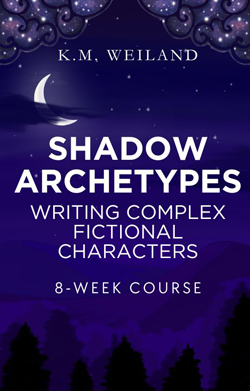K.M. Weiland's Blog, page 4
March 3, 2025
Your Character’s Three Choices: Character Goal Examples for Writers
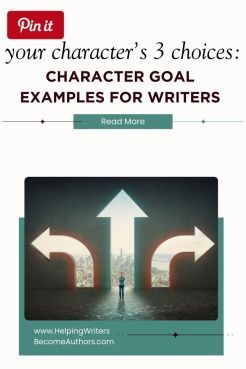 Most writers understand that strong character goals are essential to a compelling story. But did you know that within every plot, three distinct types of goals shape every character’s journey? These are fundamental, primary, and secondary goals. In exploring these character goal examples for writers, you can gain a clearer understanding of how character, plot, and theme work together seamlessly. Inspired by Robert Fritz’s concept of human choice-making, these three types of goals offer a practical framework for crafting characters whose decisions resonate deeply with readers.
Most writers understand that strong character goals are essential to a compelling story. But did you know that within every plot, three distinct types of goals shape every character’s journey? These are fundamental, primary, and secondary goals. In exploring these character goal examples for writers, you can gain a clearer understanding of how character, plot, and theme work together seamlessly. Inspired by Robert Fritz’s concept of human choice-making, these three types of goals offer a practical framework for crafting characters whose decisions resonate deeply with readers.
At the heart of every memorable story is a character driven by choices. Some of those choices are grand and overarching, others are small but significant. Robert Fritz’s framework (found in his book The Path of Least Resistance: Learning to Become the Creative Force in Your Own Life) identifies three types of choices we all make in real life. As writers, this can help us better understand the cause and effect of our characters’ motivations and plot actions, not only to discover their most prominent plot goals, but to also understand the deeper motivations and perspectives driving those goals.
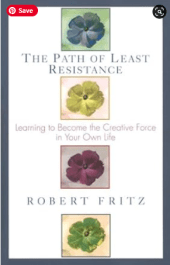
The Path of Least Resistance by Robert Fritz (affiliate link)
As defined by Fritz:
Fundamental choices define who characters are at their corePrimary choices shape characters’ immediate journeys.Secondary choices influence the actions characters take along the way.Understanding these layers allows you to build characters whose desires, conflicts, and growth feel authentic, providing a solid foundation for powerful storytelling.
More than that, we can see a parallel between each of these layers and the three most important engines of story: plot, character, and theme. Each of Fritz’s “choices” corresponds to one of the “Big Three.”
In This Article:The Three Different Choices That Create Character GoalsThe Fundamental Choice = Your Story’s ThemeFundamental Character Goal Examples for WritersThe Primary Choice = Your Story’s Character ArcPrimary Character Goal Examples for WritersThe Secondary Choice = Your Story’s PlotSecondary Character Goal Examples for WritersThe Three Different Choices That Create Character GoalsWhen crafting strong character goals, it’s important to recognize not every choice characters make carries the same weight. Fritz’s framework of fundamental, primary, and secondary choices provides a practical guide for writers looking to create well-rounded characters. Each type of choice serves a distinct purpose, establishing characters’ core identities and driving their moment-to-moment decisions. Let’s break down each of the three choices to examine how they work together to create dynamic characters.
1. The Fundamental Choice = Your Story’s ThemeOn his website, in an article titled “The Fundamentals,” Fritz says:
There is [a] type of choice upon which all other choices rest, and that is the fundamental choice….
Fundamental choices are about orientation, states of being, the ground you stand on. There are four major fundamental choices we recommend to people. They are:
The choice to be healthyThe choice to be freeThe choice to be true to yourselfThe choice to be the predominant creative force in your own life
As the foundation of the other choices, the fundamental choice is the underlying motivation for all subsequent choices and actions. Think of it as your characters’ prime directive. This is their guiding principle, their deepest reason. As such, it can sometimes be buried so deeply, it isn’t consciously obvious even to themselves.

Writing Your Story’s Theme (Amazon affiliate link)
The fundamental choice will usually align with the deepest and most thematic layers of the Lie the Character Believes and/or the story’s thematic Truth or the Thing the Character Needs. Most likely, it will exist on an abstract level. For example, if a story’s thematic Truth is Fritz’s “choice to be free,” characters may not be conscious of it as such. Rather, they may personally frame this thematic Truth as something more practical to their specific lives such as, “I choose not to submit to my tyrannical boss.”
Of course, this practical, more specific choice could also be the emergent of a different fundamental choice (i.e., it could emerge from any of the fundamental choices cited by Fritz). This is where we start to discover the wonderful complexity available within the seemingly simplistic concept of a story’s Lie/Truth. Even though life seemingly points to only a very small handful of absolute Truths (all of which are abstract to at least a certain degree), the ways they can play out in the specifics of individual lives and stories is infinite.
Note, too, that in contrast to Fritz’s examples, a character’s fundamental choice need not always be a positive representation of a story’s Truth. It may just as likely represent the Lie itself, such as when a pessimistic character bases subsequent choices on a fundamental belief in the worthlessness of society. It is also possible that characters who hold positive fundamental Truths will have to work through Lies manifesting on lower levels that are holding them back from fully embodying the positive choice. This might be the case with a character whose positive fundamental goal is to be free, but who holds a lower-level Lie, for example, that “aggression is the only way to escape.”
Fundamental Character Goal Examples for WritersBand of Brothers: The soldiers’ fundamental goal is to serve their country and what they believe is the greater good. This is based on their fundamental choice to be loyal to each other and committed to their duty no matter the cost. This is their core state of being—brotherhood and honor above all.
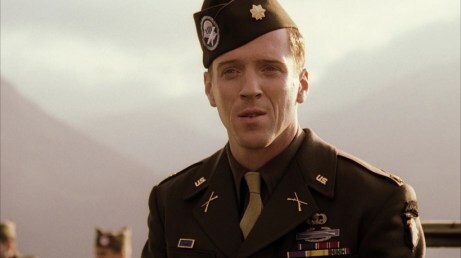
Band of Brothers (2001), HBO.
Pride & Prejudice: Although largely in a reactionary role throughout the story, Elizabeth Bennet’s plot goals emerge from her fundamental choice to stay true to herself and her values, prioritizing integrity and genuine connection over societal expectations.

Pride & Prejudice (2005), Focus Features.
Coming to America: Prince Akeem’s fundamental goal of honoring true love is based on the fundamental choice to be true to himself and find genuine love, rather than simply fulfilling royal expectations.

Coming to America (1988), Paramount Pictures.
2. The Primary Choice = Your Story’s Character Arc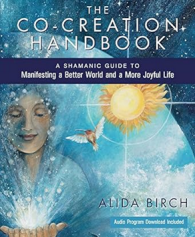 In The Co-Creation Handbook, Alida Birch describes the primary choice like this:
In The Co-Creation Handbook, Alida Birch describes the primary choice like this:
A primary choice is a choice which supports the fundamental choice. For example, if happiness is one of your fundamental choices, then you might take time out from your usual routine to do something that reminds you of your choice to be happy. Or you might choose to be employed in a meaningful job thereby fulfilling your fundamental choice to create a purposeful life. Or you might choose to commit to a more healthful diet to support your fundamental choice to be healthy.

Writing Archetypal Character Arcs (affiliate link)
The primary goal that results from this choice will likely represent your story’s overall plot goal. This is the Thing Your Character Wants, which will motivate all subsequent actions in the plot. For example, if a character’s fundamental goal is to be free, then the primary goal—the plot goal—might be to overthrow the tyrannical boss and restore worthy leadership to the company (a Queen Arc!).
Depending on the type of character arc your story features, the primary goal can ultimately be aligned with either the Lie or the Truth. As mentioned above, even if your characters hold a positive fundamental goal, the primary goal might still represent the foundational Lie they must overcome in order to be successful in achieving the worthy purpose represented by the fundamental choice. For example, in a different story, a character with the positive fundamental goal of freedom might have to work through a misaligned primary goal resulting from a Lie such as “the only way I can assure my own freedom is to control others.”
In most stories, the Thing the Character Wants (and therefore the primary goal) will start out aligned with the Lie. This doesn’t necessarily mean the Want itself is negative, but it does mean the characters must learn to adapt more effective and positive primary goals on their way to gaining (or sometimes giving up) the Want.
Primary Character Goal Examples for WritersBand of Brothers: The soldiers’ fundamental commitment to their duty translates into the more specific plot concerns of doing their part as paratroopers and, hopefully, winning the war. Each episode in the story focuses on a specific primary goal—usually various missions, such as Normandy, Market Garden, and Bastogne—that support the larger fundamental goal. Each soldier chooses to endure the hardships of war—physical exhaustion, fear, and loss—because of their commitment to each other and the mission.

Band of Brothers (2001), HBO.
Pride & Prejudice: Elizabeth makes difficult primary choices based on her fundamental commitment to her own values and integrity. She chooses not to marry for convenience or wealth, even when pressured, because it would compromise her self-respect and beliefs. She also demonstrates how primary goals can evolve over the course of the story: as her perspective of Mr. Darcy becomes more accurate, she alters some of her specific decisions while coming into deeper integration with her higher Truth (e.g., she initially rejects Darcy’s proposal of marriage, but then changes her mind).
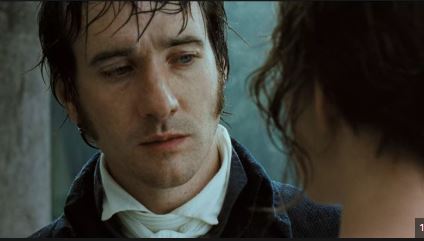
Pride & Prejudice (2005), Focus Features.
Coming to America: Prince Akeem solidifies his fundamental goal of marrying for love into the specific plot goal of traveling to Queens, New York, and pretending to be a poor immigrant in order to find a partner who loves him for himself rather than his wealth or status.
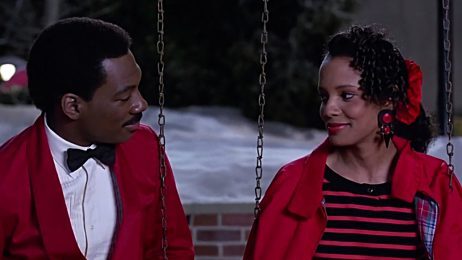
Coming to America (1988), Paramount Pictures.
3. The Secondary Choice = Your Story’s PlotFritz explains the secondary choice:
Once we know what is primary… we may need to make strategic secondary choices in support of our primary choice. If we want to create health, we may need to make a series of secondary choices such as eat a healthy diet and exercise. We might not make these secondary choices if we didn’t have health as a primary choice, but we gladly do them when we know our higher order organizing principle: in this case health.
Secondary goals are where things get real. If the fundamental goal is a nice abstraction and the primary goal is a specific intention, the secondary goal is the determination of actionable steps that can be taken in pursuit of those higher-order goals.
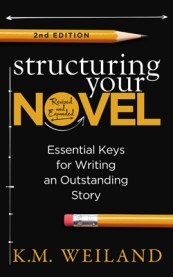
Structuring Your Novel: Revised and Expanded 2nd Edition (Amazon affiliate link)
Within a story, these are the scene goals. This is where and how plot unfolds on a moment-to-moment basis within the story (which is also what evolves character arc).
In pursuit of a conscious primary goal and a (perhaps) unconscious fundamental goal, characters will choose the specific actions they believe will lead them to their ultimate goals. With a fundamental commitment to personal freedom and a plot goal of unseating a tyrannical boss, characters might then choose scene goals that involve petitioning management, organizing a workers’ strike, or speaking to a journalist. Whether or not these scene goals are effective will prove how aligned they are with whatever overall Truth is necessary for success.
As characters learn and grow in the effectiveness of their secondary choices, they will also evolve their character arcs—refining any limiting beliefs or Lies that are keeping them from acting in full integrity with their fundamental Truth. If their fundamental goal is, however, not ultimately worthy or true, they will also have the opportunity to learn how to exchange that faulty fundamental belief for one that is more accurate and advantageous.
Secondary Character Goal Examples for WritersBand of Brothers: The characters’ fundamental and primary goals translate into day-to-day, scene-by-scene decisions for each man, such as following orders, protecting comrades, storming enemy positions, and offering emotional support to one another.

Band of Brothers (2001), HBO.
Pride & Prejudice: Elizabeth’s pursuit of her fundamental and primary goals creates scenes in which she undertakes specific actions and responses, such as rejecting Mr. Collins’s proposal, challenging Darcy’s initial arrogance, and defending her family’s honor.
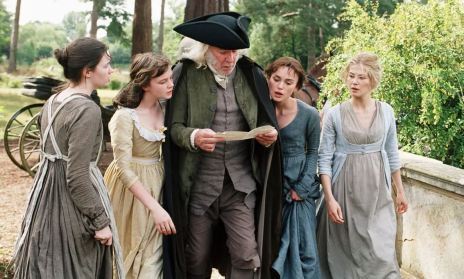
Pride & Prejudice (2005), Focus Features.
Coming to America: Akeem enacts his primary goal of finding a worthy queen by undertaking specific scene actions, such as working at McDowell’s, cutting his prince’s lock to hide his royal identity, and pursuing his boss’s daughter despite their cultural differences.

Coming to America (1988), Paramount Pictures.
***
Although you shouldn’t take the correlation of each of these choices to theme, character, and plot too literally (since they are all intertwined), this exploration of fundamental, primary, and secondary choices can be a useful tool in creating a cohesive foundation for your story. Understanding the three types of character goals can help you better understand your characters’ inner workings and how to realistically explore the evolution of choices and actions that create compelling character arcs.
By clearly defining each layer, you can craft characters whose decisions, motivations, and growth feel authentic and meaningful. This framework not only supports your characters’ internal journeys, but also enriches plot and enhances theme. With these distinctions in mind, you’ll be able to dig deeper into your character’s desires and motivations, ensuring their journeys remain consistent and powerful from start to finish.
In Summary:Understanding the three types of character choices—fundamental, primary, and secondary—can provide writers with a deeper insight into how character goals drive plot and theme. By exploring Robert Fritz’s concept of human decision-making, writers can craft characters whose motivations resonate with readers on multiple levels, creating compelling stories with authentic character development.
Key Takeaways:Fundamental Goals define a character’s core values and motivations, often reflecting their deepest beliefs or the thematic truth of the story.Primary Goals are the immediate objectives that create the character’s character arc and drive the overall plot arc.Secondary Goals are the specific actions or scene goals that support both the fundamental and primary goals in creating the plot.By understanding and applying these three types of goals, writers can create dynamic, multi-layered characters whose decisions feel grounded in both the story and their personal journeys.Want more?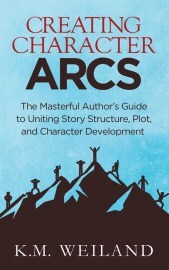
Creating Character Arcs (Amazon affiliate link)
If you’re looking to dive deeper into the heart of character development, my book Creating Character Arcs is the perfect guide. In this book, I break down the essential elements of crafting character goals and show you how these layers shape a character’s transformation and tie into your story’s broader theme and plot. Whether you’re a beginner or a seasoned writer, this book can help you develop characters who resonate with readers and drive a compelling, cohesive narrative. If you’re ready to transform your characters into unforgettable, dynamic forces, you can check it out at retailers like Amazon or via the store on my site.
Wordplayers, tell me your opinions! What are some of your favorite character goal examples for writers? Can you identify their fundamental, primary, and secondary choices? Tell me in the comments!Click the “Play” button to Listen to Audio Version (or subscribe to the Helping Writers Become Authors podcast in Apple Podcast, Amazon Music, or Spotify).
___
Love Helping Writers Become Authors? You can now become a patron. (Huge thanks to those of you who are already part of my Patreon family!)The post Your Character’s Three Choices: Character Goal Examples for Writers appeared first on Helping Writers Become Authors.
February 24, 2025
Do Great Writers Know the Ending First?
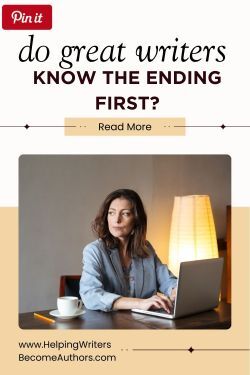 Note From KMW: One of the big debates in writing is whether great writers know the ending first before they ever start drafting. Some writers thrive on the certainty of a clear destination, while others prefer to let the journey unfold organically. But which approach leads to the strongest stories?
Note From KMW: One of the big debates in writing is whether great writers know the ending first before they ever start drafting. Some writers thrive on the certainty of a clear destination, while others prefer to let the journey unfold organically. But which approach leads to the strongest stories?
Personally, I’ve never sat down to write an outline, much less a first draft, without at least thinking I knew the general ending. However, there’s no one-size-fits-all answer. This is why understanding the pros and cons of each method can help you find the right balance for your own process. A solid ending can provide direction and focus, but some writers find that too much rigidity stifles creativity. On the other hand, writing without a planned ending can lead to exciting discoveries—but also to meandering plots and frustrating rewrites.
Today, I’m pleased to share a post from Daryl Rothman, who shares convincing examples from both sides of the road. Whether you’re a meticulous plotter or a spontaneous discovery writer, his insights can help you understand how knowing (or not knowing) your ending will shape your creative process.
***
In This Article:Famous Authors Who Knew Their EndingsDo All Great Writers Plan Their Endings? A Different PerspectivePlotter vs. Pantser: Which Writing Method Works Best?John Irving once noted:
I write the last line, and then I write the line before that. I find myself writing backwards for a while, until I have a solid sense of how that ending sounds and feels. You have to know what your voice sounds like at the end of the story, because it tells you how to sound when you begin.

The World According to Garp by John Irving (affiliate link)
Hard to poke holes in his rationale, or his success with The Cider House Rules and The World According to Garp, to name but a few. Irving elaborated that he types the words and sends them as postcards to close friends (some who noted that not nary a punctuation mark evolved from conception to publication). Irving added:
You have to know what your voice sounds like at the end of the story because it tells you how to sound when you begin.
This topic evokes some immediate lines in the sand. I remember being called a pantser years ago. “Hey,” I recall protesting, in homage to Larry Fine, “I resemble that remark.” Of course, the moniker referred not to any propensity for yanking down the trousers of a mortified fellow human but rather, my tendency to favor a measure of spontaneity over assiduous plotting. In truth, I typically end up somewhere in between, or a little of everything, but the matter of pantser vs. plotter has its ardent adherents, including many who stand squarely with Irving.
Margaret Mitchell famously wrote Gone with the Wind backwards, penning the saddest parts of the Rhett Butler and Scarlett O’Hara saga before adjudicating the details of their tumultuous relationship. Mitchell wrote the book’s final moments of grief and loss first. She said:
I left them to their ultimate fate.
In a 2011 NPR interview, Joanna Arietta, director of historic houses for the Atlanta History Center and Margaret Mitchell House, noted:
She knew at the very beginning that Rhett wasn’t going to care that much and that Scarlett was going to live for another day
Mitchell shared:
“I had every detail clear in my mind before I sat down to the typewriter. I believe… that is the best way to write a book—then your characters can’t get away from you and misbehave, and do things you didn’t intend them to do in the beginning.

The Narrative of Arthur Gordon Pym of Nantucket by Edgar Allan Poe (affiliate link)
Even my beloved Edgar Allan Poe believed the finest writers composed their work with an understanding of the story’s end and the impact it should have on readers. Inclined toward the short story, Poe’s lone completed novel, The Narrative of Arthur Gordon Pym of Nantucket, contains an italicized trail of phrases for the reader to track, foreshadowing the story’s end. These impart the feel of a conceptual short story and further illustrate that the end of his tales remained always front of mind.
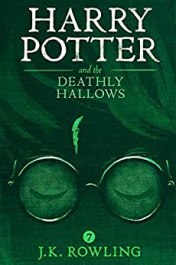
Harry Potter and the Deathly Hallows by J.K. Rowling (affiliate link)
JK Rowling wrote the last chapter of the seventh and final Harry Potter book, The Deathly Hallows, around the same time she conceived the idea for the first:
I’ve always planned seven books. These books have been plotted for such a long time, and for six books now, that they’re all leading a certain direction.
Once again, tough to argue with the staggering success her roadmap yielded.
There are countless more adherents, yet this is hardly a decided debate. Rather, it is freighted with the impassioned druthers of some dissenting heavyweights.
Do All Great Writers Plan Their Endings? A Different PerspectiveIn 2011, The Guardian revealed Great Expectations as readers’ favorite Dickens novel, yet his original ending may well have evoked a different sentiment. The initial version sees an unmarried Pip briefly reunite with Estella in London, finding she has been widowed and remarried, dashing all hope of ending up together.

Great Expectations (2012), Lionsgate.
Roald Dahl’s first iteration of Matilda was something of a cautionary tale, and didn’t even feature the bookish heroine readers came to know and love. Matilda was a naughty, unruly child (Veruca Salt anyone?) who pranked those around her and perished in the end of the book as penance for her cruelty. Fans may give thanks that Dahl’s final version changed course, softening our beloved protagonist.

Matilda the Musical (2022), Netflix.
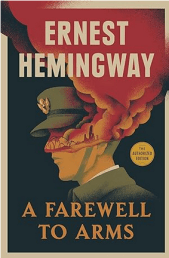
A Farewell to Arms by Ernest Hemingway (affiliate link)
And then there’s Hemingway’s 47 potential conclusions to A Farewell to Arms. This classic famously ends,
After a while I went out and left the hospital and walked back to the hotel in the rain.
Simple and sparse, inimitable Hemingway. But it would not have been had he rigidly held to one of his myriad previous conclusions.
Stephen King, one of the most prolific authors of all time, recoils at the idea of obedient plotting, feeling it extinguishes creative embers, and stunts the organic growth of the characters you have brought into the world. Most of his ideas arise from simple questions he posits, often beginning with “What if?,” and building from the possibilities that subsequently manifest. Salem’s Lot clawed its way to life from one such query: “What if vampires invaded a small New England village?” So too with Cujo: “What if a young mother and her son became trapped in their stalled car by a rabid dog?”
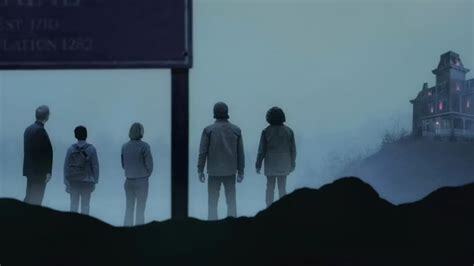
Salem’s Lot (2024), HBO Max
Plotter vs. Pantser: Which Writing Method Works Best?It is said that a friend once visited James Joyce as he wrote, inquiring upon arrival the source of the scribe’s obvious vexation. Of course it was the work, as always. “How many words did you get today?” queried the visitor. “Seven,” replied Joyce. “Seven? But James… that’s good, at least for you.” “Yes,” Joyce at last assented, before lamenting, “But I don’t know what order they go in!”
I think many writers can relate to the challenge of determining sequence and structure across an entire manuscript.
So, who’s right? Pantsers or plotters? Is it better to set down your stakes straight away, finish line forever in sight, or at least in mind—or to wing it, to breathe life into your story and its inhabitants and sit back and enjoy the ride?
The question, of course, is flawed. Hopefully, all writers have learned, even if they harbor a preference, that there is no one right way. We have heard here from only a smattering of notable scribes who have found smashing success on either side of the fence. The achievement of one approach clearly cannot be said to belie that of the other. You must find what works for you (and it might not always be the same, project to project, or as your literary journey progresses).
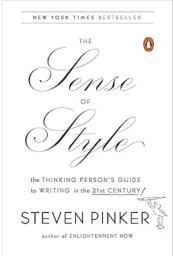
Sense of Style by Steven Pinker (affiliate link)
I wrote a piece questioning blind adherence to some of writing’s “rules,” and referred in the piece to Dr. Steven Pinker, noted Harvard linguist, author, psychologist, and cognitive scientist, who in his The Sense of Style challenges some of these sacred cows. My article focused on the great debate around word choice, and in an email exchange with Pinker, he agreed that the “Puritanical advice” which tends to undergird many style manuals and writing rules “is overdone.”
>>Click here to read The Rules of Fiction: What They Are and What They’re Not
So don’t box yourself in. Experiment.
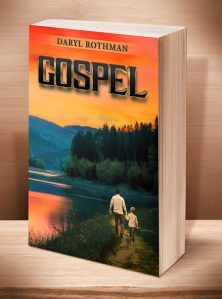
Gospel by Daryl Rothman (affiliate link)
I like to have an overall idea of story and perhaps the endgame or some goalposts, but leave the road along the way uncluttered by excessive plotting. I credit King’s practice of posing key questions. From that ember of a possibility can ignite a roaring blaze of story, character, and conflict.
King’s “key question” approach has worked well for me, especially if I further the “What if” inquiry to include something like, “but is prevented (from main objective) by….” But even if I fancy knowing the result, I humble myself sufficiently to remain open to a change, perhaps even a big one. Our stories and our characters are our babies, yes, but sometimes you must “kill your darlings,” as King famously said. Or at the very least, follow their lead.
I remember as a kid reading and then watching Shane, and when little Joey is running through the graveyard toward the climactic showdown of the film, my father said softly, “And a child shall lead them.” (A little Isaiah 11: 6 for you.)
Truth be told, it stuck with me, more for the literary lesson. My story is my baby, just as is each character. I have breathed life into them and must ultimately follow their lead, providing what guidance I can. I am not their puppet master, nor they my obedient marionettes, dancing upon my every pull of the string or punch of the keyboard. Give your characters life. Imbue them with some defining traits, build out your world a bit, and set them free upon it.
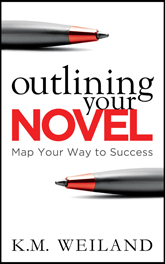
Outlining Your Novel (Amazon affiliate link)
I do outline a bit, though at the beginning I keep it fairly broad and flexible. I may outline further as I go along and I see where the story and the characters are taking me. I may jot reminders or ideas for upcoming scenes. But I try not to be intransigent: if upon arrival those ideas or scenes no longer fit, or need some tweaking, I make a course correction.
Everyone has an ego; I definitely do. Writing is one of the few things I believe I do well, and it has transpired more than once that I pen something, even a paragraph, I think to be well-written, even masterful, but there is that gnawing sense it simply doesn’t fit. It isn’t true to the story or perhaps the character. I hem and haw, grumble and groan, perhaps let slip a few nice expletives (talk about word choice), but know in my heart to leave out the misplaced verbiage.
On the other hand, I don’t like to start with nothing, rudderless, no notes, no ideas, my writerly trousers tugged down to my ankles. I typically conjure something of a roadmap but remain open to the number of detours I’m apt to encounter along the way. Flexibility within structure.
Best wishes finding the approach best for you. No better way in the end than to keep working. Good luck in your journey. Write on!
In SummaryThe debate between plotters and pantsers—whether to plan a story meticulously or allow it to unfold organically—has been central to many famous authors’ writing processes. Writers like John Irving, Margaret Mitchell, and J.K. Rowling have spoken about how knowing the ending first can help inform their writing. However, authors like Stephen King emphasize a more spontaneous approach, allowing the story to develop naturally. Ultimately, there’s no one-size-fits-all approach. Writers must find what works best for them and adapt as their creative process evolves.
Key TakeawaysPlotting vs. Pantsing: Some writers prefer to plan their endings first, believing it guides the rest of the story, while others discover the ending as they write.Famous Authors’ Approaches: John Irving, Margaret Mitchell, and J.K. Rowling all believed in starting with the ending to ensure a cohesive narrative, while authors like Stephen King take a more exploratory approach.Flexibility is Key: Whether you plot or pants, remaining flexible allows your story and characters to evolve naturally.No Right Answer: The best method depends on the writer and the specific project. It’s important to experiment and find what works for you.Wordplayers, tell us your opinions! Do you think great writers plan their endings first, or do you prefer to let the story unfold organically? Tell us in the comments!
The post Do Great Writers Know the Ending First? appeared first on Helping Writers Become Authors.
February 17, 2025
5 Proven Ways to Conquer Self-Doubt in Writing
 Self-doubt is one of the biggest obstacles a writer will ever face. It creeps in at the worst moments—undermining confidence, stalling progress, and making you question whether your stories are even worth telling. Conquering self-doubt in writing isn’t about eliminating it altogether; it’s about learning to work with it. The key is recognizing self-doubt for what it really is: not a stop sign, but a challenge to grow.
Self-doubt is one of the biggest obstacles a writer will ever face. It creeps in at the worst moments—undermining confidence, stalling progress, and making you question whether your stories are even worth telling. Conquering self-doubt in writing isn’t about eliminating it altogether; it’s about learning to work with it. The key is recognizing self-doubt for what it really is: not a stop sign, but a challenge to grow.
Not long ago, Louis Scenti wrote in about a personal challenge many writers face:
Perhaps this is a condition that many people struggle with but I feel quite alone. I can’t seem to shut off the critical voice, the saboteur, if you will, that says things like “why bother, nobody id interested in what you write,” or “you’re old and coming back to writing in your sixties—well, you just don’t have time to improve, it’s too late.”
In other words, I cannot seem to shut off my rational/critical brain and fully access the child-like part of me that finds writing pure fun; pure flow. Sometimes I can’t even sit down in my chair and face the keyboard. Any thoughts or ideas?
If you’ve ever found yourself battling a relentless inner critic—the voice telling you your writing is worthless, you’re too late, or you don’t have what it takes—you’re not alone. In fact, I’d argue all writers face this at some point (usually at multiple points) in their careers.
The inner critic often masquerades as a rational voice. It tells us that it’s just looking out for us, that it’s saving us from embarrassment, failure, or wasted effort. To a point, this is true, since the inner critic is often a highly sophisticated (and in some ways autonomous) manifestation of our inner protector—a voice we developed early in life to guide us to the safest choices. As a very young child, safety was paramount. But often this limiting protector/inner guide/critic doesn’t evolve apace with our maturing capabilities. Uncalibrated, it can remain with us our entire lives, even as its advice grows progressively less helpful and increasingly self-destructive. We could argue that the out-of-control inner critic is on a mission to destroy what it sees as our greatest enemy: ourselves.
Therefore, this voice is usually rooted in fear—of not being good enough, of being judged, or of spending time on something that may not lead to immediate validation. One of the most important things to understand about this voice is that it’s not an objective judge of your abilities. Instead, it’s a deeply ingrained response to past experiences, external pressures, and personal insecurities. The more power you give it, the louder it becomes. Alternatively, the more you recognize it for what it is, the more likely you can transform it back into a force that can legitimately guide, protect, and enhance positive growth.
In This Article:Proven Ways to Conquer Self-Doubt in Writing Your FictionEmbrace Your Inner Critic as a Necessary Archetype for Conquering Self-Doubt in WritingFace Your Fears to Overcome Self-Doubt and Unlock Your Creative PotentialRecognize Ebb Periods in Your Writing FlowExpand the Child Archetype with Creative FreedomWhy It’s Never Too Late to Be CreativeProven Ways to Conquer Self-Doubt in Writing Your FictionBecause self-doubt in writing (as in life) is all but ubiquitous, advice is everywhere. Most focuses on practical steps for either muscling past the self-doubt or building better habits to contain or redirect it. Most of this advice is good:
1. Give your inner critic a name (such as my favorite “Judgy McJudgerson”).
2. Set a timer and write anyway.
3. Open a dialogue with your inner critic by writing it a letter.
4. Change up your writing environment.
5. Find a creative ritual that supports you.
6. Remind yourself why you write.
I’ve written much in the past about dealing with the challenge of the inner critic. You can find some of those posts linked below. Today, I want to examine five ways to conquer self-doubt in writing that go deeper than just practical tips, so you can learn to address the underlying factors and motivations that keep the inner critic coming back time after time. Particularly, I want to examine each of the different “flavors” of self-doubt that Louis articulated in his query.
>>Click here to read Imposter Syndrome for Writers Is a Real Thing (+ the Key to Slaying It)
>>Click here to read Judge Yourself Less, Trust Yourself More, and Write Better Stories
>>Click here to read Afraid to Let Anyone Read Your Writing? 5 Steps to Move Past Fears
1. Embrace Your Inner Critic as a Necessary Archetype for Conquering Self-Doubt in WritingYou can’t destroy the inner critic. You can’t cut it off. You can’t stuff it inside some mental compartment and forget about it. It will always come back.
Why? Because it’s you.
Even though the toxic inner critic generally speaks in the voice of someone outside of ourselves (often an authoritarian voice, whether specific or generic), it arises from within. The only way to “get rid of it” is to integrate it—to make peace with its purpose for existence, recalibrate it into better functionality, and absorb it into our higher consciousness where we can exercise control over it.
In describing his inner critic, Louis used a key word. He wrote:
I can’t seem to shut off the critical voice, the saboteur, if you will….
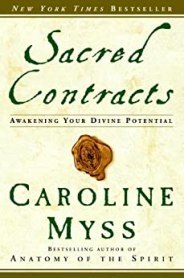
Sacred Contracts by Caroline Myss (affiliate link)
In her book Sacred Contracts, archetype maestra Carolyn Myss posits four “archetypes of survival” inherent to every personality. One of these archetypes is the Saboteur. She writes:
The Saboteur archetype is made up of the fears and issues related to low self-esteem that cause you to make choices in life that block your own empowerment and success. [Y]ou need to face this powerful archetype that we all possess and make it an ally.
Rescued from the shadow, the Saboteur/Inner Critic can once again become the Protector it was intended to be. Instead of acting as a negative voice of self-sabotage or -destruction, it becomes a neutral ally highlighting pitfalls and recommending actionable choices.
>>Click here to read The Writer’s Inner Critic: 11 Ways to Tell if Yours Is Healthy
2. Face Your Fears to Overcome Self-Doubt and Unlock Your Creative PotentialFDR’s quote has become a cliche, but it’s truer than truth:
We have nothing to fear but fear itself.
In my own adventures, as I have circled the things I want and the fear that stands in my way, I have realized that is rarely the thing itself that frightens me—it is dread of my own fear response that holds me back. I recently shared a quote I have found profound in my own creative (aka, life) journey:
Everything you want is on the other side of fear.
Here’s another one I ran onto recently, from Mary Kate Teske, which is even truer:
No one ever tells you that bravery feels like fear.
The next time you sit at the page (or feel dread at the thought of doing so), take a moment to lean into what you’re feeling in your body. Instead of naming it fear and trying to move away from it, recognize it as your instinct toward bravery. This is your creative self in its very essence—desiring growth, transformation, experience. The very fact you are experiencing this deep inner tension and discomfort signals you are unwilling to settle for the status quo. Your inner self wants more—knows you need more. Via the very discomfort that may make you feel you are not big enough or good enough to continue, you are already proving your own profound courage.
Frankly, writing is scary. I’d even go so far as to say it should be scary. At the very least, congratulate yourself for pushing your own edges.
>>Click here to read How to Overcome Fear as a Writer and Embrace Your Profound Courage
3. Recognize Ebb Periods: How to Conquer Self-Doubt in WritingIn general, writers tend to put far too much pressure on the act of writing. Yes, that part’s important (obviously), but there are many other aspects of the creative process that are equally valid and, in many instances, impossible to do without.
Some days are typing days, and some are thinking days, but both are writing days.
When we’re not actively writing every day (or sometimes even after missing just one day), our toxic inner critic’s algorithm tends to lean heavily on themes of productivity equaling worth. But just as we gain more by fully welcoming and integrating the inner critic back into a healthy role, we also achieve our best creative states when we are able to welcome and use both sides of our brain. Some people tend to emphasize intuition and emotion to the point nothing ever gets written, structured, or edited. However, many people who struggle with the toxic inner critic tend to overemphasize logic and willpower to the point they need to be reminded that sometimes not writing is actually the most creative thing you can do.
Louis wrote:
Sometimes I can’t even sit down in my chair and face the keyboard.
Each author must look within to determine whether such a circumstance is the result of running away from fear instead of moving bravely into it—or whether, in some instances, a deeper and wiser voice is offering what turns out to be a good point. Very often, the resistance to sitting down to write at least partially results from the writer’s unreadiness. Sometimes that unreadiness is best dealt with by simply diving in and creating your way out of it. Other times, inner wisdom dictates something is missing:
Perhaps a bit more time daydreaming is necessary to fully flesh out the characters.Perhaps a bit more research is required to understand how to execute the scene.Perhaps a bit more study into the mechanics of storytelling and writing would smooth the process.Rarely is it productive to shame ourselves for legitimate feelings of not wanting to “sit down and face the keyboard.” Rather, allow what is to be. Take a moment to sit with it; listen to it. There is a message of truth there if only we can learn to recognize it. Once recognized, it often transforms from an obstacle to an ally.
But how do you know if you should be listening to your resistance to sitting at the keyboard—or resisting the resistance and moving forward anyway?
The answer is probably: whichever requires more courage.
Sometimes not writing can feel like the scarier option. If so, take a look at that. But if not writing feels like an escape, then turn around and sit at the keyboard once again. Wherever you are facing your fears—wherever you are feeling your own bravery—that is where the most answers will be found.
>>Click here to read Do You Have to Write Every Day? 10 Pros and Cons
4. Expand the Child Archetype: Conquering Self-Doubt with Creative Freedom
Writing Archetypal Character Arcs (affiliate link)
At the heart of the struggle against self-doubt is the desire to reconnect with the joy of writing and the childlike sense of play that allows creativity to flow freely. The Child is another innate archetype, one intimately associated with creativity (I’ve written about in-depth about the Child here and in my book Writing Archetypal Character Arcs). One of the main quests of my own life has been the desire to understand why accessing my childhood experience of creativity became so much more difficult in adulthood and, most importantly, how do I get it back?
That saga is ongoing for me (although I made an interesting breakthrough the other day, which, if it pans out, I will share in the future). One of the keys, however, is simply remembering tenets of childhood creativity and rewiring our well-meaning adult habits to return to them.
For example:
The Child creates for the fun of it. No deadlines. No focus on productivity.If the Child doesn’t feel like creating, it doesn’t. If it feels like napping or eating or crying or laughing instead of playing, that’s what it does.The Child does not (naturally) feel guilty for not creating or for creating “badly.”The Child follows its joy (the disconnect most adults experience from embodied joy is one of our greatest creative blocks).The Child has no (or little) ego and approaches the world with the simultaneous humility and hubris of ignorance.The Child is a wide-open canvas of possibility and curiosity: it sees everything as new and potentially interesting.
Awakening the Heroes Within by Carol S. Pearson (affiliate link)
The list goes on. Returning to childhood is no small feat. Indeed, in Carol S. Pearson’s cycle of archetypes, she begins with the childlike Innocent and ends with the Holy Fool—the culmination of that lifelong quest to return to untamed wonder.
If that culmination feels a bit out of reach as yet and if your writing feels heavy, you can try the following practical approaches:
Write badly on purpose. Give yourself permission to write nonsense, knowing you can always revise later.Separate creation from evaluation. Draft first, critique later. Mixing the two is like trying to drive with one foot on the gas and the other on the brake.Reframe writing as exploration. Instead of thinking, “I have to write something good,” try “I wonder where this sentence will take me?”>>Click here to read Not Feeling Creative? 4 Ways to Reignite the “Wonder” in Your Writing
5. It’s Never Too Late to Be CreativeLouis brings up one more important aspect of the inner critic—its ability to weaponize time against us. Writers returning to their craft after years (or decades) away, or those first picking up the pen after a lifetime of other pursuits, may feel an intense pressure to “catch up.” The critic whispers they don’t have enough time to improve, that they missed their chance, or that they should have started earlier.
But creativity isn’t a young person’s game. Many successful authors didn’t publish their first books until their fifties, sixties, or later. Frank McCourt published Angela’s Ashes at 66. Laura Ingalls Wilder published Little House in the Big Woods at 65.
Every chapter of life brings its own challenges and opportunities. Creativity and its expression remain our most important asset at every stage of life. In each chapter of life, we are someone new. In each chapter, we have something to say that is important. The stories and archetypes of the Third Act of life are not the same as the stories of the First Act. Experience is a writer’s greatest asset. You have lived more life and gained more wisdom and perspective. You bring something to the page younger writers simply can’t. The fear that it’s “too late” is an illusion designed by a dysfunctional inner critic to keep you from taking action.
More than that, I believe everything you write adds value to the world. The very act of writing changes reality. It changes you. It’s like investing advice: the best time to start is today.
>>Click here to read The 3 Acts of a Writer’s Life—Or How Your Age Affects Your Writing
***
Although the inner critic isn’t likely to ever fully disappear, it doesn’t have to be in charge. You don’t have to wait for permission to create, and you don’t have to prove your worth before you start.
Writing is an act of courage at any age, in any season of life. The only way to silence the voice that says “why bother?” is to sit down and write anyway.
In Summary:Self-doubt is a common struggle for writers, often stemming from fear of failure, perfectionism, or external criticism. Overcoming these doubts is possible through intentional mindset shifts and strategic habits. By recognizing negative thought patterns, setting realistic goals, and cultivating a supportive creative environment, writers can build confidence in their abilities. Ultimately, the key to conquering self-doubt lies in persistence, self-compassion, and a focus on growth rather than perfection.
Key Takeaways:Self-doubt is a challenge, not a stop sign. Recognizing it as a natural part of the creative process allows you to work with it instead of against it.Your inner critic is not your enemy. Reframe it as the Protector archetype and transform it into an ally that guides rather than hinders you.Fear signals opportunity for growth. Instead of avoiding fear, lean into it as a sign you’re stepping beyond your comfort zone.Creative ebbs are natural and necessary. Not every moment needs to be productive. Sometimes stepping back leads to deeper insights.Reignite your childlike creativity. Approach writing with curiosity, playfulness, and a sense of wonder rather than pressure.It’s never too late to start writing. Your experiences add richness to your storytelling, no matter when you begin.Want more?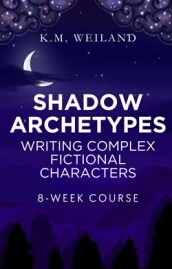 As you can see from what we’ve been talking about today, understanding archetypes—and their shadows—is a valuable resource that can help you break free from creative self-doubt and write with greater depth and confidence. My eight-week email course Shadow Archetypes: Writing Complex Fictional Characters explores how these deep psychological patterns shape both your characters, by extension, you as well. In recognizing and working with shadow archetypes, you can uncover new layers of complexity in your storytelling that can help you transform inner obstacles into strengths. If you’re interested in joining me in bringing your most compelling characters to life, you can find out more here.
As you can see from what we’ve been talking about today, understanding archetypes—and their shadows—is a valuable resource that can help you break free from creative self-doubt and write with greater depth and confidence. My eight-week email course Shadow Archetypes: Writing Complex Fictional Characters explores how these deep psychological patterns shape both your characters, by extension, you as well. In recognizing and working with shadow archetypes, you can uncover new layers of complexity in your storytelling that can help you transform inner obstacles into strengths. If you’re interested in joining me in bringing your most compelling characters to life, you can find out more here.
Click the “Play” button to Listen to Audio Version (or subscribe to the Helping Writers Become Authors podcast in Apple Podcast, Amazon Music, or Spotify).
___
Love Helping Writers Become Authors? You can now become a patron. (Huge thanks to those of you who are already part of my Patreon family!)The post 5 Proven Ways to Conquer Self-Doubt in Writing appeared first on Helping Writers Become Authors.
February 10, 2025
Exploring the Impact of AI on Fiction Writing: Opportunities and Challenges
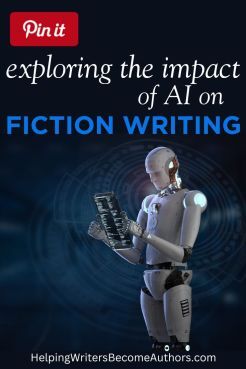 Artificial intelligence is changing the way we do just about everything these days, and the impact of AI on fiction writing is no exception. As a writer who cherishes the creative process, I have spent the last few years grappling with both the possibilities and pitfalls this new technology brings. On the one hand, AI offers tools that can make our lives easier—such as helping with research, marketing, and even ideation. On the other hand, it raises questions about originality, authenticity, and the integrity of human storytelling.
Artificial intelligence is changing the way we do just about everything these days, and the impact of AI on fiction writing is no exception. As a writer who cherishes the creative process, I have spent the last few years grappling with both the possibilities and pitfalls this new technology brings. On the one hand, AI offers tools that can make our lives easier—such as helping with research, marketing, and even ideation. On the other hand, it raises questions about originality, authenticity, and the integrity of human storytelling.
Almost as soon as ChatGPT and its brethren were unveiled in November 2022, writers started emailing me for my opinions—most with an (at least) subtextual request for reassurance that AI wasn’t as potentially disruptive as it seemed to be. I have been cautious in sharing my opinions, since my own contextual understanding of the functionality of AI and its big-picture ramifications weren’t yet formed. More than two years later, it has become clear that AI is simultaneously not as apocalyptic as some may have originally thought while also being, in some ways, even more disruptive, particularly in the long term, to the systems that undergird nearly every part of our modern lives. This includes the impact of AI on fiction writing, which continues to evolve as new tools and capabilities emerge.
I need to be clear that my own experience with and opinions of AI are ever-evolving. In contemplating this article in the weeks leading up to writing it, the ideas I thought I might be sharing have already changed multiple times—sometimes daily. The utility and causality of AI is vast and, in itself, constantly evolving. In truth, I don’t think most of us will truly understand our relationship to AI until many years, perhaps even decades, down the road. My own opinion in this moment is that the best approach is one of cautious practicality.
In This Article:Why Writers Need to Embrace AI… to a PointConcerns About the Impact of AI on Fiction Writing: What Writers Should KnowHow AI Can Be Useful to WritersThe Single Greatest Threat AI Poses to Fiction Writing (Hint: It’s Not What You Think)Is AI Going to Make Writers Extinct?Why Writers Need to Embrace AI… to a PointThe writers I have talked to about AI have largely fallen into two camps—those who find it terrifying in its capacity to change comfortable, time-honored, and beloved systems and structures (both in and out of the creative pursuits) and those who find it giddyingly delightful in its potential for play, innovation, and convenience.
Concerns about the ethics of AI’s origins in training, without permission, off the works of untold authors (myself included) have been thoroughly discussed by this point. Lawsuits and regulations are still unfolding, all of which will be crucial to navigating this brave new world in which we find ourselves.
My own first reactions to AI were sober. I wasn’t someone who jumped in with both feet like I have with past technologies. However, I’m also not one to cry over spilt milk. At the very least, I feel the presence of AI in our world is now irreversible. I’m not sure yet if the proper analogy is that of a wish-granting genie having been let out of the bottle or of Pandora having opened a box of shadow-horrors. Either way, it’s here, and there’s no getting it back into the bottle or the box. Certainly, there is the argument that even if we could, that might not be the best choice anyway.
Therefore, I believe it is important for writers, just like everyone else, to embrace the new future in which we find ourselves. Resistance born of denial ultimately harms no one more than ourselves. Just as the Internet was a shatterpoint that forever altered the world in my early teens, AI will certainly unfold in ways both good and bad. The point is: the world has changed. How can we best respond so that we both survive and thrive, not just collectively but as individuals and, particularly in this context, as writers?
To do so, we must use AI. As it becomes more integrated into everyday functionality (such as Google searches), this will become more and more intuitive and less and less optional. More than that, experimenting with AI—ChatGPT, Midjourney, etc.—is important not just in understanding this new world and forming educated opinions about it, but in gaining entry-level skills that will likely become increasingly important to our ability to succeed as technology evolves.
Think about writers who did not or would not adapt to the opportunities the Internet brought 20+ years ago. Those who did are currently thriving thanks to their ability to navigate related software, retail sites, and social media. AI represents a similar seachange, and the truth is we don’t yet know which AI-related skills will be not just optional, but crucial, in future years. Resisting the urge to stagnate in a comfortable status quo is the essence of character arc and therefore story. We’re in the midst of quite a story right now. It’s best to be an active protagonist, rather than a passive sidekick.
Concerns About the Impact of AI on Fiction Writing: What Writers Should KnowThat said, of course, AI must be embraced with awareness and caution, since its full impact is constantly unfolding and therefore not entirely knowable. Many writers are already seeing the impact of AI on fiction writing in the ways books are discovered, marketed, and even created.
Some concerns include:
Ethics of AI TrainingThe ethics surrounding how AI learns, etc., and what it produces will continue to be a topic of interest for writers. My own take (again, as someone whose books were used for training the original models) is that although it would have been preferable to have had a conversation before rather than after, the way AI learns and creates isn’t really any different from how any one of us learns and creates—just on an unlimited scale. I’m not going to put any more effort into resisting AI’s extrapolation of my work than I am the thousands of human writers who learn from me and then go on to write about their own integrations of “my” theories.
Resource Consumption of AIOne of my greatest concerns about AI—which is spoken about regrettably seldom—is its tremendous resource consumption. The energy and computational costs of of AI systems, especially during training, is staggering. For example:
Water Usage: Training large AI models can consume significant amounts of water. Training GPT-3 in Microsoft’s U.S. data centers required approximately 700,000 liters (185,000 gallons) of water for cooling purposes.Energy Consumption and Carbon Emissions: The energy demands of training AI models are considerable. A study from the University of Massachusetts Amherst found that training a single large AI model can emit over 626,000 pounds (approximately 284 metric tons) of CO₂, which is nearly five times the lifetime emissions of an average American car.Although usage for individual tasks (such as you or I using ChatGPT or a Google search) seems insignificant in comparison (i.e., each query or interaction may consume a few kilowatt-seconds of energy, roughly comparable to the energy used to power a light bulb for a few seconds), the cumulative effect of billions of queries worldwide adds to the toll.
Discoverability ChallengesAI has already—and will continue to—evolve how books are discovered. Although, in itself, this is not a problem, as search discoverability is always evolving, there are legitimate fears that as AI search begins to dominate, opportunities for discoverability will narrow. Obviously, this affects not just writers wanting to be discovered, but also all of us who, as consumers, are trying to discover new and interesting books (among other products) that may exist beyond the obvious top tier.
Two-Dimensional and Sometimes Erroneous InfoMuch has also been written about AI’s fallibility. From notorious Google searches that recommended running with scissors to obvious programming biases, AI’s ability to control how we see the world is cause for unequivocal concern. As we become more and more familiar with large language models (LLMs) and companionable chatbots, the challenge to remain vigilant about the validity of information and our own perceptions of it will become more and more crucial.
The Single Greatest Threat AI Poses to Fiction Writing (Hint: It’s Not What You Think)Most of the above applies to anyone interacting with AI. What about writers?
We are only at the cusp of the possibilities for how AI may integrate into fiction writing. Already many writers are embracing its capabilities to help them learn, research, outline, plot, edit, and publish. AI has already proven its ability to be of tremendous help in the creative process. To the degree AI legitimately makes us more creative (which is not necessarily to be conflated with more productive), it will ultimately prove to be a positive and expansive tool. But in this process, it is important for each artist to consciously and consistently perform the personal gut check of acknowledging the line where AI becomes the creator rather than the creative tool.
As we explore a future in which we will increasingly collaborate with AI, I would encourage all humans to question whether or not we are choosing to interact with AI in ways that makes us less human or more. This is particularly important for writers, artists, and creatives of all types, as it is our act of creation that most defines our humanity, first individually and then collectively.
AI is a decidedly “mental” tool. It is designed to think. As such, it is uniquely positioned to help us with all mental tasks. (Perhaps someday it will dream and emote, but even then, do we want it to dream and emote for us?)
For instance, some of the ways AI can be most useful to writers is by:
Relieving the mental stress of busy to-do lists.Helping with administrative duties, copywriting, ads, social media, etc.Helping with research.Helping with search engine optimization.
Outlining Your Novel (Amazon affiliate link)
It can be tempting sometimes (especially for plot-oriented or outline-forward writers) to think storytelling is a mental process. However, the mental aspects of writing are just a small part of the overall experience and, often, the last aspect to fully emerge. Story is not just a mental game; it is a deeply felt creative embodied process. As such, I am cautious about advocating the use AI for story creation without significant caveats.
How each writer chooses to use AI (whether in brainstorming, outlining, co-writing, etc.) is ultimately as individual and personal as each person’s writing process was before AI popped out of the box. That said, I encourage every creative to carefully consider how you implement AI into your creative process.
Ask Yourself: Why Are You Using AI?What are your specific goals and reasons for bringing AI on board?
Perhaps you enjoy it.Perhaps you feel the necessity of the changing times.Perhaps you recognize obvious ways AI can simplify the always difficult process of creating a story.Perhaps you seek greater productivity.All of these are valid responses as long as the results are not inhibiting or distracting from the deeper experience of creation. Stories are a conversation first with our own subconscious and eventually with the greater shared subconscious of the collective. It is not too great a stretch to say that our interaction with the deep archetypes of story itself and the characters who populate it is what shapes our very existence. Story is not just communication; it is communion—with ourselves, with each other, and with the infinitude that lies beyond immediate understanding.
The Sacredness of StoriesStories are sacred. This doesn’t mean we can’t (or shouldn’t) bring in AI tools to aid us. Indeed, insofar as AI is an extension of ourselves or an aid to our own deep subconscious creativity, then it can only be a positive. But honoring the sacredness of story does mean we must be careful not to allow AI’s easy answers to bypass the depth of our creative processes. For me, the storytelling process has always been a conversation with my deep subconscious—my dreaming self, if you will. I’m not interested in what AI comes up with; I’m interested in what I come up with; I’m interested in what you come up with.
More than that, although AI may enhance creativity, productivity, and efficiency, it also risks diminishing our own skills. For instance, can AI help you learn how to write a book? Can it teach you story theory? The short answer is: yes. But only as an aid.
Why? Because, again, story is not simply a mental skill or the ability to recite certain storytelling formulae. It is an embodiment. Indeed, some of our best authors couldn’t recite a formula or articulate story theory to save their lives—and yet they have written deeply embodied works of art that have not only connected with the collective subconscious but evolved it.
In many ways, the purpose of AI is to offer shortcuts. Obviously, there are both good and bad aspects of this. Just as the Internet has rewired our brains, AI will undoubtedly change the way we think. As creators, we are the life force of society. As writers, we are its voices. The choices each one of us makes in how we use AI to, first, live our lives and, second, to write our stories will ripple far beyond ourselves. What each of us does at this epochal moment in history and how we choose to interact with technology matters.
The specifics of how we make these choices are extremely personal—not least because there is no clear “right” path. What is most important—and what I challenge every writer—is to remember we are the sovereigns of our own lives. We are responsible for our choices. Therefore it is incumbent upon each of us to remain aware of what we are doing, why we are doing it, and how our choices and actions are impacting our relationships with our deepest selves and therefore with our storytelling.
***
Someone once asked me if it was even worth becoming a writer in this rapidly changing age of AI.
First, let me comment on the pitfalls of pinning too much despair (or, equally, hope) on the impact AI has on fiction writing. Writers have always been anxious about publishing (really, getting published and not getting published are equally scary). These days, it can be easy to project our anxieties or fears onto AI and use it as a convenient scapegoat for throwing up our hands, saying “what’s the point?”, and not doing the thing that scares us (whether that’s writing or publishing). Often, new technologies like AI can become bogeymen that conveniently distract from more personal fears.
Now, as for the specific question of whether AI will render novelists and other creatives obsolete—who knows? But my personal opinion is absolutely not. Although AI and other tech will inevitably change the way we create, the single most important dynamic in art is the artist who wants to say something and the audience who wants to experience communication in this way from a fellow human. The impact of AI on fiction writing will not change the fundamental human need to create and to experience human creation. So keep creating! We’re all in the midst of a tremendous story right now, and, as it should be, that is both terrifying and exciting!
In Summary:AI is revolutionizing fiction writing, offering both exciting possibilities and daunting challenges. While its integration into creative processes can enhance productivity, it also raises concerns about originality, ethics, and the sustainability of resource use. Writers must strike a balance—embracing AI as a tool for efficiency and exploration, while remaining conscious of its potential impact on their creativity and humanity. The future of writing lies in navigating this technological shift with care, ensuring AI serves to enrich rather than overshadow our deeply personal and emotional journey of storytelling.
Key Takeaways:AI tools are changing the landscape of fiction writing, offering both opportunities and challenges for authors.While AI can assist with brainstorming, editing, and productivity, it lacks true creativity and emotional depth.Ethical concerns arise regarding AI-generated content, originality, and the potential impact on human writers.Writers can benefit from AI by using it as a supplement rather than a replacement for their creative process.The role of AI in publishing and discoverability is still evolving, requiring authors to stay informed and adaptable.Want more?
Writing Archetypal Character Arcs (affiliate link)
In a world where AI is reshaping the landscape of storytelling, it’s more important than ever for writers to tap into the deep, timeless forces that make our stories resonate on a profound level. If you’d like to move deeper into that, you might enjoy my book Writing Archetypal Character Arcs. I wrote it to help you understand and harness the power of archetypes to create characters that not only drive your plots but also connect with the universal themes that speak to our shared human experience.
While AI can be a valuable tool in the writing process, the true heart of storytelling lies in our ability to explore and express these archetypal depths. If you seek to create stories that stand the test of time, Writing Archetypal Character Arcs is a guide to crafting characters who speak to the most important human transformations. You can check it out at retailers like Amazon or via the store on my site.
Wordplayers, tell me your opinions! How do you think the impact of AI on fiction writing will shape the future of storytelling? Tell me in the comments!Click the “Play” button to Listen to Audio Version (or subscribe to the Helping Writers Become Authors podcast in Apple Podcast, Amazon Music, or Spotify).
___
Love Helping Writers Become Authors? You can now become a patron. (Huge thanks to those of you who are already part of my Patreon family!)The post Exploring the Impact of AI on Fiction Writing: Opportunities and Challenges appeared first on Helping Writers Become Authors.
February 3, 2025
The Writer’s Road to Creative Burnout Recovery
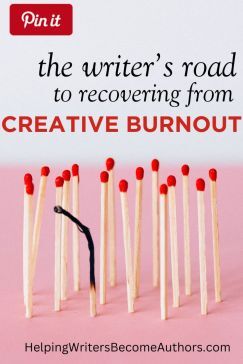 Creative burnout can feel like a wall between you and your writing goals. Whether it’s the result of stress, distractions, or feeling creatively drained, creative fatigue and even injury is something many modern writers experience. Because writers are generally a solution-forward bunch, we often think we can ten-step our way out of the problem. However, when creativity itself is the problem, the resources to heal can often be counter-intuitive. Creative burnout recovery isn’t about forcing your way back to the page; it’s about holistically creating space in the rest of your life for your creativity to breathe and rebuild.
Creative burnout can feel like a wall between you and your writing goals. Whether it’s the result of stress, distractions, or feeling creatively drained, creative fatigue and even injury is something many modern writers experience. Because writers are generally a solution-forward bunch, we often think we can ten-step our way out of the problem. However, when creativity itself is the problem, the resources to heal can often be counter-intuitive. Creative burnout recovery isn’t about forcing your way back to the page; it’s about holistically creating space in the rest of your life for your creativity to breathe and rebuild.
Last fall when I asked you all what you’d like me to write about this year, quite a few of you brought up challenges you were having in accessing, restoring, or implementing your creativity:
So sorry I have not really had the time to read your blog these days. I have not even had the chance to write either which…for me…is a tragedy. And to be perfectly honest, it is difficult for me to use my inner creativity muscle anymore. But that does not mean I can’t. I would like you to write more about finding the joy of writing and ways to battle against writer’s “disinterest.” I will not call it a block.–MC Furgal
Having experienced deep creative burnout myself, these are topics about which I am extremely passionate. In my own experience and from what I hear from the writing community, creative burnout is becoming an increasingly common challenge for many modern writers. Although the pandemic crisis in 2020 launched many people’s creative aspirations, it was also a shatterpoint for many long-time creatives. There are many possible reasons for this, but to me this points to the reality that creative burnout is often the result of what may seem at first to be “supra-creative” causes. Although writer’s block may often appear to be specifically related to the act of writing (as in some cases of what I call “plot block”), it is more often a symptom of deeper obstacles blocking the flow and force of our deepest creative selves—which is to say, our very lives.

Conquering Writer’s Block and Summoning Inspiration (affiliate link)
To risk creative burnout is, truly, to risk the burnout of our deepest life force and vitality. Likewise, to heal any injuries or exhaustion in our relationship to creativity, we must be willing to look beyond the page to examine those things that may be blocking, not just our writing, but our lives.
That said, today I want to respond to MC’s question by looking at the practical steps I’ve learned over the years in my own creative burnout recovery and in daily building the kind of life that supports this vital energy.
In This Article:What Creative Burnout Really MeansSeeking Emptiness: The Problem of “Filling the Well’ in Creative Burnout RecoveryMinimizing Unnecessary (and Sometimes Necessary) Noise, So You Can Hear the MuseListening for Your Yes: The Path to Creative Burnout Recovery and Rediscovering Your Writing FlowWhat Creative Burnout Really MeansWhat is creative burnout? Put simply, it’s when you reach that point when there’s nothing left in the tank.
Although lack of creative desire is often the first symptom that something might be going awry, the resistance felt is different from the usual—and quite normal—pushback most writers feel when confronted with the empty page. In creative burnout, the will might still be present, but the passion is gone. The desire for desire might be present, but the old spark just isn’t there. The motivation has run dry. Writing, even at its best, requires a difficult and even painful stretching of oneself, but there is always a purpose, a reason, a motivation to keep going. With creative burnout, there just isn’t.
MC wrote that it is “difficult for me to use my inner creativity muscle anymore.” I like this metaphor of a “muscle,” since it extends to include the idea of an injury. Creative burnout is really creative injury. Understanding this helps resolve the shame, confusion, and self-recrimination that often complicates this experience. Treating burnout as an injury allows us to turn doctor and explore the root causes of what can otherwise seem a mysterious hex.
Although every experience of creative burnout will be as deeply unique as creative expression itself, most instances can be traced or at least related to one simple factor: stress.
The most important thing to understand about stress—and therefore about creative burnout—is that stress is a physiological experience. It happens to the body. This can have wide-ranging effects—from muscle tension and inflammation to nervous system dysregulation to rewired brain patterns (e.g., anxiety triggers, attention deficits)—and all the host of further snowballing conditions and illnesses (e.g., high blood pressure, etc.) It’s not something to be taken lightly. Although creative burnout by itself can seem comparatively minor (!), it is often an early caution against further lifestyle dangers.
Recognizing this is one thing. Dealing it with in a modern technological world that seems to become more complex and stressful by the day is another challenge altogether. Few of us live simple or streamlined lives. Between relationships, jobs, finances, home and auto maintenance, and a host of other calls upon our attention, we are busier than ever. On top of that, our sleep is increasingly dysregulated, thanks in part to our near-constant exposure to blue light. Even our downtime isn’t really downtime. Instead of creating space for routines that allow our systems to actually empty, reset, and refill, we’re usually either chasing dopamine highs (i.e,. checking off fun stuff like it’s a to-do list) or numbing out (probably with more screentime).
This is just the norm now. Speaking for myself, I can draw a direct correlation between the increasing busyness of my mind throughout my adult decades and the corresponding decrease in my ability to “dream” and therefore to access creation from the deepest well of myself rather than simply my overworked head center. Breaking away from these unhealthy and ultimately creativity-destroying lifestyles requires the conscious awareness and effort to create days that are filled with high-quality habits (but not too full, if you know what I mean).
Seeking Emptiness: The Problem of “Filling the Well’ in Creative Burnout RecoveryThe first step in creative burnout recovery is creating space in your life where you can invite creativity back in.
In the past, discussions of writer’s block have often focused on the seemingly generative idea of “filling the well.” However, the very term writer’s block tells us the problem isn’t necessarily a lack but perhaps a superfluence. The longer I have experienced, researched, and responded to my own creative blocks, the clearer it has become to me that the real problem is not that my creative well is empty of ideas or information, but rather that my system in general is too full. When an overloaded brain and nervous system run too hot for too long the result is, of course, burnout.
Because burnout is physiological, it is not a state that can always be easily reversed. Just as with a car engine that has been run into the ground, some pieces may be beyond salvaging and may need to be replaced. In the case of a living organism, this replication is miraculously possible, but it takes time, patience, and the discipline to create the ease and space that creative energy craves.
Here are a few practical tips for creating space into which you can re-invite your creativity:
1. Do What’s in Front of YouThis has become one of the mantras of my life. Basically, it means “clear the table” (or the desk, as the case may be). Clear the clutter by starting with what’s right in front of you. Although this might indicate actual clutter, more generally it recommends against procrastination. The more stuff that piles up (literally or metaphorically), the fuller our brains get. Even when we may not actively remember everything (like that unanswered email or the leftovers in the fridge), some part of your brain does remember. It puts a pin it, and when you never get back to it and a hundred others like it, the mental real estate it requires takes up more and more space that could otherwise be used for creativity.
2. Go Slow Enough to ProcessIn some respects, this is another variation of “do what’s in front of you”—except here what’s “in front of you” are the thousand little mental and emotional responses that arise throughout the day to one prompt after another. We interact with infinitely more bits of information and stimuli than have previous generations. Although our amazing brains quickly filter, sort, and process most of these occurrences, some take a little more time. When we are unable to pause in the moment to fully acknowledge or process our responses, they still get backed up in the body. In the constant flow of information, that particular catalyst may be mentally forgotten, but not physically.
Get into the practice of noticing your responses as they arise. When something feels triggering or like it requires an extra moment to process, take a break, step back, and fully digest it before moving on—all of which can take as little as a few seconds of awareness. Particularly in our scroll culture, in which we may encounter dozens, if not hundreds, of possible triggers within a short timespan, slowing down enough to learn this practice offers untold benefits.
3. Write Down or Look Up Questions ASAPYou know those random thoughts and curiosities that filter through your brain throughout the day? How tall is Elizabeth Debicki? How may Super Bowls did Tom Brady win? Which brand of crackers is cheaper? To the degree you intend to “look that up later,” do it now. This is yet another form of “doing what’s in front of you.” Don’t let trivia backlog in your brain. Use your phone to look it up right now. If you intend to text someone, do it now. If you need to add something to your grocery list, put in your online cart or write it down now. Not only does this reverse procrastination habits, it is also one of the simplest ways to remove unneeded complexity from your daily brain and your probably already overtaxed short-term memory. Wouldn’t you much rather think about your story rather than crackers? (Or not. I mean I love crackers.)
Minimizing Unnecessary (and Sometimes Necessary) Noise, So You Can Hear the MuseOne of the biggest brain clutterers is noise. And there is so. much. noise right now. If you spend any significant amount of your life online (and who doesn’t?), then you hear the noise. Some of that noise is from your own life. Some of it is literal noise. And some of it is just the general clutter and chatter of the Internet—emails, ads, news, to-do lists, even entertainment. We all know how easy it is for our hours and our good intentions to run down the drain after getting sucked into what started out seeming like an inconsequential browse through suggested YouTube shorts.
Here’s the thing: the Internet is not going to help you take control of your brain back. Our modern world is not going to help you. If you want your brain back—if you want your creativity back—you have to do it yourself. And I’ll be honest: this is a Sisyphean battle. Short of pulling the plug on the Internet and/or having superpower-level self-discipline, I envision this as one of Dwight Eisenhower’s battle plans—where basically you have to keep throwing it out and creating new ones on the go.
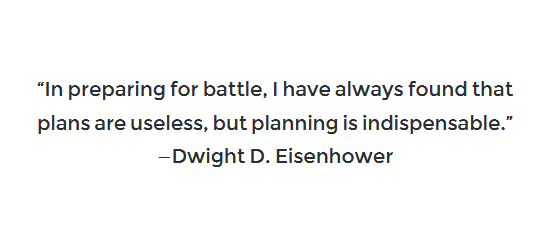
Here’s what I’m doing this year to take care of my brain.
1. Browse One Tab at a TimeThe hyper-multitasking of the Internet has literally rewired our brains into shorter attention spans and memories. One of the only ways to combat this is to force yourself to go slower. (I know, I know, it feels like pulling teeth to me too.) In the past, my daily Internet routine was to open every single tab I would need for the day (email, blog comments, socials, financial institutions, etc.), then go through them as fast as I could. If one page was loading (I have slow Internet), I’d skip back and forth between tabs. I think I could literally feel my brain dying.
This year, I made the commitment to only open one working tab at a time. I am shocked by how much calmer my brain feels. I will never go back.
2. Use a Pomodoro Timer to Take BreaksA Pomodoro timer is a time-management tool that breaks your work into focused intervals, typically 25 minutes long, followed by a short 5-minute break, helping boost productivity and prevent burnout. I also started using this tool more faithfully this year. I will work sitting for 25 minutes, use an eye massager during the 5-minute break, then raise my desk to standing for 15 minutes, before repeating. Not only does it help me reorient, give me time to process anything that’s come up during the 25 minutes, and slow my roll on any time-suckers, it also gives me the chance to address my body’s needs.
3. Limit Social MediaI know, I know. This one is almost a cliche at this point. But it’s the truth. Social media can be fun and useful, and for those of us who use it for marketing, it can even be obligatory. But there’s no question it is, at best, a necessary evil. Aside from always being a potential black hole for our time and attention, it is also designed to bombard us with a host of small stimuli that fill up our brains with empty calories and encourage low-quality wiring in our memories and nervous systems. I gotta be honest: the less time spent on short-form content, the better. If you love it or need it, set a timer—then give yourself at least a few minutes afterward to let everything you saw and heard process through.
4. Commit to No-Buy MonthsThis one might not seem immediately obvious, but aside from bringing less actual stuff into your life (and saving money), it can also free up more of your attention. One way or another, most of us spend a lot of time shopping—whether necessarily or recreationally. Especially if you shop predominately online, creating structure around not just how much you can buy but, in this instance, particularly how much time you spend looking can not only free up time and space, it can also help cut down on the unavoidable noisiness of everything that happens out here in Internet-land.
5. Set Realistic Schedules and Goals for Your LifeWe have to manage so much complexity in our modern lives. The better we organize our lives, the more structures and resources we can utilize to help us quiet everything down enough to create an inviting space for our creativity. One important way of doing this is making sure the structures and tools we bring in to help are, in fact, realistic. Trying to cram in too much (guilty!) won’t help your creative burnout recovery, no matter how well-organized it is. Get real about what’s important and what you have time for. If creativity is important, then prioritize that—even just in making space so your brain can quiet down.
>>Click here to read Creativity vs. Distraction: 13 Tips for Writers in the Age of the Internet
Listening for Your Yes: The Path to Creative Burnout Recovery and Rediscovering Your Writing FlowOnce you’ve cleared space in your life and brought healing to your stress injuries, how can you proactively welcome creativity back into your life?
This will require new habits. After all, if the old ones hurt you, you know you have to stop. You can’t go back to doing the same things that led to creative burnout the first time around.
This can be a tough pill to swallow. Just recently (after many years of creative burnout recovery), I finally found myself consciously realizing that part of me was trying to heal just so I could return to the same level of productivity I managed before my burnout. That’s the definition of insanity.
You have to be willing to examine whether you might have to let go of some the ways things used to be. There can be an ego death and a grieving process involved with that.
You can also ask yourself whether you might, in fact, be able to return to some good things as well. One of the best ways to cultivate good creative habits is to think back to times when creativity overflowed. Think back to the perfect ease of daydreaming and play-acting when in childhood. Creativity seemed effortless then because it was allowed to arise, rather then being recruited as a soldier in the army of productivity.
Although creativity ultimately uses and requires all aspects of the self, including the intellect and the will, it begins as an inherently intuitive and even emotional process. When we talk about “making space” for creativity, what we are talking about is the space where the creativity begins. We are making space for creativity to arrive. Although we may often think of “the act of creation” as something we do, it is a deeply receptive act. True creativity is not so much when we think of something as when that thought thinks us. There’s no forcing that. There is only waiting, listening, and cultivating a physiology that is habituated to experience the creative act as pleasurable rather than stressful.
>>Click here to read How Meditation Can Inspire Your Next Story
Even before taking the steps mentioned above, you must have a willingness and ability to go through what is often a literal detox from “go mode.” If creative burnout results from our brains rewiring in unpleasant ways (albeit to protect and/or serve us), then creative burnout recovery is about rewiring our miraculously plastic brains and systems back into generativity. Go mode is highly addictive, which is, again, another physical experience. It’s not just in our heads; it’s not just a “habit”; after a while, it becomes part of our physical reality. Changing that reality requires changing certain fundamental things about the way we interact with all parts of our lives.
Not every writer is committed enough to their writing to make those changes. And that’s fine. There’s nothing wrong with deciding to move on after burning out on one expression of creativity. But we cannot move on from creativity itself. It is our very life force. It is the best and truest part of our existence, no matter how it expresses. Although the modern world and its technologies offers a plethora of unthought-of tools and environments that can help creativity thrive, there are also many aspects absolutely antithetical to the maintenance of a healthy creative life. Without awareness and discipline, more and more writers are likely to suffer creative burnout—not because there is anything inherently wrong with their “creative muscle,” but because the potentially endless distractions and stresses we face every day are, in fact, creative death by a thousand cuts.
Although creative burnout is a challenge many writers face, it is also an unprecedented opportunity to reconnect with the essence of creativity itself. By stepping away from the constant demands of modern life and creating space for rest, reflection, and renewal, we can rediscover the joy and vitality that fuels our writing. The process of recovery requires patience and the willingness to let go of old habits, but it also offers the chance to build a more sustainable and fulfilling creative practice for the future. Remember, creativity thrives in moments of stillness and openness. By nurturing those moments, we not only heal our creative selves, but also open the door to the deep, rich stories that resonate with our true selves.
>>Click here to read How to Rediscover the Joy of Writing
In Summary:Creative burnout isn’t just a temporary slump; it’s often a deep-seated physiological and emotional response to overwork and stress. It’s not about the absence of ideas but about a system that’s too full to allow creativity to flow. To recover, we need to create space in our lives to heal and rejuvenate, both mentally and physically. A critical first step is slowing down, clearing mental clutter, and consciously addressing stress that’s been building in our lives. Real recovery requires not only rest but also adjustments to our habits and schedules to maintain balance.
Key Takeaways:Creative Burnout Is a Physiological Injury: It’s not just a lack of motivation but a deeper, systemic issue rooted in stress and mental overload.Create Space for Recovery: To heal from burnout, it’s important to clear physical and mental clutter. Slow down, process emotions, and avoid procrastination.Minimize External Noise: Limit distractions, especially online, to allow your mind the space to reset.Practical Strategies: Implement tools like Pomodoro timers, limit social media, and commit to no-buy months to reduce external pressure and regain control over your time and attention.Set Realistic Expectations: Overloading your schedule exacerbates burnout. Set achievable goals and leave room for recovery.Wordplayers, tell me your opinions! What strategies have you found most helpful in your own creative burnout recovery journey? Tell me in the comments!Click the “Play” button to Listen to Audio Version (or subscribe to the Helping Writers Become Authors podcast in Apple Podcast, Amazon Music, or Spotify).
___
Love Helping Writers Become Authors? You can now become a patron. (Huge thanks to those of you who are already part of my Patreon family!)The post The Writer’s Road to Creative Burnout Recovery appeared first on Helping Writers Become Authors.
January 20, 2025
How to Get Better at Self-Editing Your Fiction: 8 Vital Steps to Follow
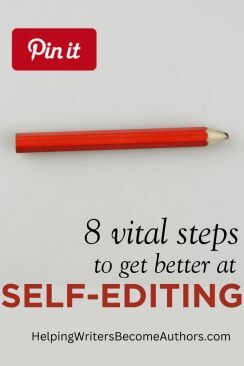
Note From KMW: I’m often asked to create more resources about self-editing your fiction. The thing about good editing is that really it’s just good writing. All the same principles apply. The only difference is whether you’re better at applying those principles (plot, character arc, theme, engaging narrative, dialogue, etc.) off the cuff in the first draft—or (like most of us) after a bit of time and perspective in the second draft.
So really, the answer to “How do I edit my story?” is “Learn good storytelling principles and figure out where your story isn’t fulfilling them.
But, of course, editing tends to feel a little more overwhelming than that. At the end of writing a first draft, most of us tend to either feel a general sense of “this is good!” or the unease of “something‘s wrong.” Either way, where do you start that all-important second draft?
Today, I’m pleased to share with you a guest post from Ali Luke of the popular writing site Aliventures. In it, she guides you through the foundational elements of moving through the big-picture edits of the second draft into the more minute and specific concerns of the third draft.
***
When you think about “writing a novel”, chances are you’re picturing the drafting part of the process: getting words down onto a blank page. While that’s a huge (and exciting!) part of the writing process, there’s a lot more that goes into a complete novel. For many writers, self-editing your fiction takes as long as—or longer—than producing the first rough draft.
Self-editing your fiction is when you go back through your own writing, making changes to improve it.
This is your chance to truly see your story come together. Perhaps it felt like your first draft didn’t quite live up to your vision for the story. As you edit, you’ll see that story come together and fully take shape.
It can be tricky to know how best to approach the self-editing process. So here’s a straightforward, systematic eight-step process you can use to work through your novel.
First Draft to Second Draft: 4 Steps of RewritingIt’s tempting to start editing by opening up your first draft and looking for little, obvious things—like typos and grammatical errors. But while those will need fixing eventually, you want to focus on the bigger picture first. You don’t want to perfect a scene … only to find it later makes sense to cut it altogether.
Here are four big steps to follow as you work through rewriting your first draft.
Step 1: Take Some Time Off … Then Re-Read the Whole ThingTake a break between finishing Draft One and starting Draft Two. There’s no magic formula for how long a break to take, but I like to have at least a couple of weeks off, ideally a month. That way, when you come back to your work, you’ll be able to see it with fresh eyes.
After your break, sit down and read through your whole first draft, making brief notes or annotations if that’s helpful. You don’t have to do this in a single session, but I find it helps to keep it to no more than a few days. That way, you can get an accurate sense of the current state of your story.
Step 2: Get Your Story’s Timeline Firmly Nailed DownOnce you’ve done an initial quick read-through, you’ll want to work through your manuscript more closely. My first step is usually to fix the mess that I’ve made of my timeline!
When you’re drafting, you might not have a clear sense of when something is happening in your story’s timeline. If you’ve got a linear narrative, it might clearly take place between Event A and Event C, but are those a week or a month apart? And if you’ve got dual timelines going on, it’s even more important to keep everything straight.
I like to create a timeline spreadsheet where I track each chapter or scene; the point of view character; and the day, date, and time the chapter or scene takes place. This helps me figure out if I need to make changes.
Step 3: Look at the Balance of Action, Dialogue, and DescriptionDoes your first draft feel like it’s a little out of balance? That could be because you’re leaning too heavily on one element of story—while having too light a touch with others.
Personally, I struggle with writing descriptions, so that’s what I generally need to add in. I’ll have plenty of dialogue and some moments of action, but my characters can come across as talking heads in a featureless room.
The “right” balance of these elements will depend in part on your genre and your personal writing style. Some genres are naturally action-packed (think thrillers and adventure stories). Others may lean more heavily on description and world-building (like fantasy and science-fiction novels).
Step 4. Check Whether Your Pacing is Too Fast, Too Slow (Or Both!)In your first draft, it can be really tricky to get the pacing right. You might spend several days writing a 3,000 word chapter, which takes perhaps 10 minutes to read. Action that seemed painstakingly slow as you wrote it may now seem to whip by too fast.
Or you might have the opposite problem. When you drafted your chapter, perhaps with some long breaks in the process, it wasn’t obvious to you that you’d spent 50% of it describing your character’s thoughts. As you re-read, it’s painfully slow.
The rewriting stage is a great chance to refine your pacing, slowing up, speeding down, and tweaking as needed.
Second Draft to Third Draft: 4 Steps for Detailed EditingOnce you’ve addressed the big-picture issues and you’ve got a solid second draft, it’s time to move on to more detailed self-editing, line by line.
Tip: Not quite at that stage yet? You can go back to Step 1 and do a full pass through your novel again.
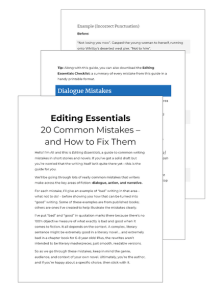 There are loads of things you can look out for during detailed editing (I cover a total of 20 in my short ebook Editing Essentials). Here, I’ve chosen the four that can make the biggest difference to how your work is perceived.
There are loads of things you can look out for during detailed editing (I cover a total of 20 in my short ebook Editing Essentials). Here, I’ve chosen the four that can make the biggest difference to how your work is perceived.
I don’t think any writer finds formatting and punctuating dialogue an exciting task, but getting this right is so important.
Dialogue has some unique rules and conventions, and if you break these, you’ll either confuse readers (who may not know which character is speaking) or look a bit amateur.
Punctuation in general can be tricky for fiction writers, but when it comes to dialogue, there are some unique rules, like:
Always start a new line for a new speaker.Use a comma before a dialogue tag. (“I agree,” John said.)Use a period before an action beat. (“I agree.” John set his book down.)If you’re not 100% sure you’re setting out your dialogue correctly, take a look through the Author Learning Center’s 8 Essential Rules for Punctuating Dialogue.
Step 2: Watch Out for Unintentional RepetitionRepetition is a powerful (and pleasing) tool , but unintentional repetition will jar readers out of your story.
Here are a couple of examples of unintentional repetition, with the repeated words highlighted:
“I’m just glad we made it back,” Joanna said, sharply, and turned her back on Tom.
This looks like the author hasn’t noticed “back” was used twice. Even though the word means different things each time, it’s will stick out awkwardly to the reader.
Tom sighed. “You don’t have to be like that.”
“Like what?”
“You know exactly what.” He sighed.
Tom repeats the same action twice (sighing). While most examples aren’t quite this close together, it’s easy to accidentally write a character who defaults to a particular action or dialogue phrase.
Step 3: Cut Down Wordy SentencesWhen you’re busy drafting or rewriting a big chunk of your novel, it’s perfectly normal for your sentences to come out a little convoluted. Perhaps you’ve packed an awful lot into a single sentence, or you were going for a particular tone that didn’t quite work.
As you make detailed edits, watch out for overly long sentences. If they feel wordy or overladen, see if you can trim them down. Is every word essential? Could you split a complicated sentence into two or three shorter ones?
Step 4: Avoid Outlandish Alternatives to “Said”Another mistake that tends to make writers seem inexperienced is reaching for the thesaurus to come up with alternatives to the (perfectly good) dialogue tag “said.”
If you’ve noticed a character opine, aver, proclaim, utter, or exclaim, you’ll know these “said-bookisms” can be distracting. Instead of focusing on the dialogue itself, you start wondering what outlandish tag the author is going to reach for next.
To avoid using “said” an excessive number of times, use dialogue beats some of the time instead. You can also let some lines of dialogue stand alone, as long as it’s clear who’s speaking.
***
Editing your manuscript can feel daunting, but by approaching it systematically, you’ll get to see your story truly come together. Whether you’re self-publishing or seeking a traditional publishing deal, it’s crucial to get your story into the best shape you can before it goes out to your editor or beta readers.
Wordplayers, tell me your opinions! Have you got a great tip for self-editing your fiction? Or is there a particular aspect of editing you struggle with? Tell me in the comments!The post How to Get Better at Self-Editing Your Fiction: 8 Vital Steps to Follow appeared first on Helping Writers Become Authors.
January 13, 2025
The Rules of Fiction: What They Are and What They’re Not
Before I get to today’s post on the rules of fiction…
I have to acknowledge the terrible tragedy of the fires in LA this past week. My heart breaks a little more each day. There are so many people affected by this who have impacted my own life in ways large and small. The scale and the effect of what is happening to them and to so many others is beyond words.
If you are one of those who have been affected or whose family or loved ones have been affected, please know that my heart’s prayers are with you right now.
For anyone looking for ways to help, I will share that the charity I chose to donate to was All Hands and Hearts.
And now back to writing—because storytelling is never a frivolous pursuit in times like these. The stories we tell matter. They tell us who we are, how we will face our darkest tragedies, and who we will become as we rise from the ashes.
Before we get to today’s post/podcast, I’m linking to a few pertinent posts from the archives as a reminder of hope and purpose in this moment:
The Power of Hopeful Stories in a Stressful Time“There and Back Again”: The Lord of the Rings and the Power of Despair in FictionWhy There’s No Such Thing as “Just a Story”5 Reasons Writing Is Important to the World***
 Writers tend to have a lot of questions about the rules of fiction—those elusive guidelines that shape our narratives and mold our creative endeavors. Are these rules rigid dictates that threaten creative autonomy? Or do they serve as an underlying structure, providing frameworks that nurture and enhance storytelling prowess? The answers are found in digging down to the true essence of fiction rules—exploring what they are, what they decidedly are not, and to what degree we should adhere to them in crafting stories that work.
Writers tend to have a lot of questions about the rules of fiction—those elusive guidelines that shape our narratives and mold our creative endeavors. Are these rules rigid dictates that threaten creative autonomy? Or do they serve as an underlying structure, providing frameworks that nurture and enhance storytelling prowess? The answers are found in digging down to the true essence of fiction rules—exploring what they are, what they decidedly are not, and to what degree we should adhere to them in crafting stories that work.
Even just a cursory search into the rules of fiction brings up a dizzying array of opinions. Although many studious articles promise to share “the rules of fiction,” many titles are dismissive. As I scrolled through the results, I found a post I had written many years ago, the title of which fit right in: “Writing Rules? We Don’t Need No Rules!”
Is this really true? Most articles with titles like these will tell you why art cannot be contained by rules—and then tell you why you should follow the rules after all. This reflects the mixed relationship most writers, particularly those just starting out, have with the rules. Sometimes I get a comment or an email from writers declaring their creative genius is too great to be bound by convention and the rules are just for stupid hacks (notably, these emails often suffer from missing capitalization and punctuation). Other times, I hear from studious new writers who are consumed with worry about learning how to do absolutely everything by the rules.
Obviously, both approaches are extremes. The true value—and caution—of the rules lies somewhere in between.
Can Creativity Follow Rules of Fiction?So do writers have to follow “the rules”? Depends entirely on how you define rules.
Much of the debate about the value of the rules of fiction comes down to definition. The very idea that something as inherently innovative and chaotic as creativity can or should be contained by rules often has writers panicking and rioting. For many writers, the discovery that there is such a thing as “rules of fiction” creates a feeling of claustrophobia. After all, much of the joy of writing is its pure freedom. Indeed, many people who might have been writers got scared off early on by such mind-numbing school exercises as the dreaded Roman numeral outline.
The word “rules” inevitably triggers our superego’s notion of a stern authoritarian (and perhaps even tyrannical) figure telling us what we are and are not allowed to do and threatening consequences if we don’t fall into line. Not exactly the stuff of inspiration, much less fun.
And creativity needs fun in order to thrive. It needs that attitude of play, of childlike curiosity and wonder. The idea of “rules” can seem antithetical to that.
However, if you stop to think about it, the idea that fiction—or any other art form—can exist without structure is clearly untrue. Even just at the level of spelling and grammar, agreed-upon conventions are necessary to foster communication. At root, that’s really all “the rules” are—conventions recognized for their efficacy in communicating within a common language.
As with any system, balance is necessary. We need a little dose of the newness of Chaos, but we also need Order. We need a liberality that embraces the evolution of innovation, but we also need the conservatism of the old guard passing down the literary legacy. We need Creativity, but we also need Logic. We need freedom, but we also need structure. The former is impossible to sustain without the latter.
The trouble comes either when writers want to throw all the rules out the window in the belief they need to reinvent the form—or when writers feel pressure to conform for the sake of conformity. Really, the whole trouble is that when we speak about the rules of fiction, we’re really not talking about rules at all. We’re not even, as the pirates would have it, talking about guidelines. We’re talking about deeper truths of both the art form and its reflection of reality. Coming to an understanding of what the rules really are can help all writers deepen their comprehension of the art form and their ability to create freely within it.
Today, let’s take a quick overview of what the rules of fiction are and are not.
What the Rules of Fiction Are NotGuidelines From Some Grim Writer in the SkyLet’s examine the most fundamental misconception first. The word “rules” tends to bring with it the subconscious idea that someone “out there” must be reinforcing those rules. Sometimes we might assume this is the gatekeepers—agents and editors—but the underlying belief is that the “right way” to create fiction was handed down to us from on high like some literary version of the Ten Commandments. Break the rules, and a lightning bolt is sure to strike your poor little novel and shrivel it into ash.
This belief can also evoke a feeling of resentment and jealousy in unpublished authors who can point out so many successful novels that clearly did not follow the rules. But although certain conventions and archetypes certainly do exist (as we’ll explore in a minute), the idea that they have been passed down by any foundational authority is simply untrue.
Peer-Enforced, Fiddly Little DictatesWriters may also sometimes sense that the rules will be enforced from the outside-in by peers. After all, everybody’s got an opinion about how to write a book. Especially in the beginning, most new writers will tout “the rules” to fellow writers, insisting on mutual observance. Often, this group accountability can be wonderfully helpful and educative. But writers must recognize that just because someone in their writing group or “everyone” online seems to be touting an unbreakable rule doesn’t mean they a) know what they’re talking about any more than you do or b) have any authority whatsoever over your choices for your story.
ImmutableAll writers can breathe a sigh of relief now. Writing rules are not immutable. As such, they clearly aren’t even “rules.” They can be broken. They will be broken. And thank God for that. Creativity demands experimentation and innovation. As my pal Ian Malcolm always says, “Life will find a way.” Any system that errs too heavily toward control (order, logic, etc.) will become tyrannical and destroy itself. This doesn’t belittle the vital importance of Order, but we must remember that its entire function is to recognize and foster the fruits of Creativity.
ArbitraryWith the above in mind, it is equally important to acknowledge that the rules of fiction are not arbitrary. They exist for good reasons, ones that contribute to the deep truths of the art form and of communication. Tongue in cheek, we often say that if there is one rule of writing, it is simply, “Know the rules before you break them.” What this speaks to is the necessity of understanding the deeper meaning upon which any seemingly arbitrary rule is founded. Once you understand that, you can determine whether breaking it is truly the most functional choice for your story.
Genre Tropes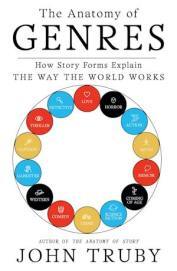
The Anatomy of Genres by John Truby (affiliate link)
Writers often confuse general rules of fiction with genre tropes. Although genre conventions do guide how particular types of stories are written as a sort of mutual contract between writer and reader, they are not rules. Genre offers archetypal guidelines for how to tell different stories of the human experience (as brilliantly explored in John Truby’s recent book Anatomy of Genres), but despite what newbie writers sometimes think, the individual tropes (e.g., romance‘s “enemies to lovers” or fantasy‘s “chosen one” or mystery‘s “incompetent police”) are not rules and do not have to be followed as such.
Life or DeathTHE RULES. They just sound so… serious. So many of us take the rules very seriously (to the point sometimes of a cultural trauma response). Mess up the rules and you’re doomed. Not only will no one ever publish you or read you or take you seriously as a writer, but, actually, this is just proof you’re a horrible person under it all.
Really, I think this is why so many writers experience knee-jerk hatred toward the idea of rules for art. And it just ain’t so. This is the voice of the toxic inner critic, one many writers confront. The toxicity of this voice doesn’t mean “the rules” themselves are toxic, but recognize if this is how you’re interacting with them, so you can move into a more balanced and generative perspective.
What the Rules of Fiction AreSo far, we’ve basically established the rules of fiction are not rules. And yet, it seems they should still generally be observed? Let’s examine what the rules of fiction really are.
TheoryAt root, the rules of fiction are simply theory—story theory. They are the collective and emergent theories writers and readers have collected over the past couple millennia about “what makes a good story.” Because of the profound body of work available to us all to study—and because we learn story through osmosis even when we’re not consciously studying—this huge context means these theories are now highly evolved.
However, they’re still theories, and they are still evolving. With every new story added to the larger context, the information that creates these theories increases, allowing for infinite revision and refinement. Nevertheless, at any given point, they offer a tremendous amount of information about our predecessors’ trial and error. From that, we can continuously extrapolate what seems most effective in communicating with readers.
Patterns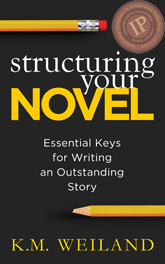
Structuring Your Novel (Amazon affiliate link)
At the root of theory is pattern recognition. Story theory is entirely based on examining the patterns that emerge from the large body of recorded storytelling. When we can examine thousands of years of story and recognize that certain plot beats are found consistently all the way back to Homer, we can confidently extrapolate that this is a pattern that has stood the test of time. From there, as story theorists, we get to explore why these patterns of plot structure are so enduring—and why we might do well to apply them in our own stories.
Archetypal Truths
Writing Archetypal Character Arcs (affiliate link)
Which came first: the Archetype or the Truth? Certainly, arguments can be made that the patterns of story point straight to the immutable truths of the human experience. But at the least, the patterns themselves have given rise to archetypes that have become truth, or at least representative of truth. As such, most of the rules of fiction point to deeper principles than simply effective communication. Everything from the underlying structure of character arc and theme to dictums such as “write what you know” and “leave out the parts readers tend to skip” point to deeper psychological reasons than may be immediately evident.
Functional FormsWhy follow the rules of fiction? The most convincing argument is simply “because they work.” If you want to write a good book, get published, and sell lots of copies, your best bet is to base that book upon the functional forms represented by the rules. This doesn’t mean you have to (or should) follow every rule (and certainly, as I hope is clear by this point, not slavishly). It also doesn’t mean that any bestseller that broke some obvious rule is somehow proof that all rules are bogus. But start with the rules of spelling, punctuation, and grammar, then work your way up to the rules of dialogue, POV, and narrative, and round out your journey with the rules of plot, character, and theme. Congrats. You’ve just created a functional storyform.
Logic, Functioning as the Handmaiden of CreativityBecause of the false paradox that is often created between Logic and Creativity, writers may balk at the rules of fiction simply because they are logical. The very fact they are based on emergent patterns means they are a recognition of the logic inherent in story. More than that, we are then able to move beyond simply perceiving the patterns to proactively using logic to extrapolate and hypothesize about them. Much of this is in service to simply understanding the patterns/rules. But it is also in service to further innovation, aka creativity. If you understand the rules (the patterns) of good fiction, you have the possibility of getting ahead of the curve by creating the next big innovation in the cycle.
As ever, the caveat here is that Logic and Creativity must exist in balance on their two opposite ends of the polarity. The whole system falls apart if writers overvalue the “logic” of the rules (in fact, this overvaluation is actually illogical). Equally, however, a rejection of the importance of logic is also destructive. At its simplest, to reject logic in storytelling is to reject a true aid. An understanding of the logic of story and the rules of fiction can only help you wrangle all that wild creativity. When you understand story theory and the rules of fiction, you have the opportunity to unburden your creativity and let it fly free with far more confidence and safety.
A Contract Between Writer and ReaderFinally, the rules of fiction can be seen as a contract between writer and reader. Readers (and viewers) enter your story as an act of faith. They are opening their minds and their hearts to you, not to mention committing money and time. As such, they are entitled to expect a good experience. Whether or not that experience is good will depend in no small part upon how well the writer understands the rules of the game.
Note, however, I didn’t say how well the writer follows the rules. You can dot all your i’s and cross all your t’s without having a clue what you’re doing or why. But from the reservoirs of a deeper understanding of the principles that underlie the rules of fiction, you will create an experience that both holds and challenges readers in all the best ways.
***
The debate over the rules of fiction unfolds because writers grapple with whether the rules are stifling constraints or foundational structures. The varied relationships writers have with these rules, from outright defiance to rigid adherence, underscores the need for balance. In essence, the rules of fiction offer a stalwart harmony between creativity and structure, enhancing story by respecting the principles of effective communication.
Wordplayers, tell me your opinions! How do you approach the rules of fiction in your writing? Tell me in the comments!Click the “Play” button to Listen to Audio Version (or subscribe to the Helping Writers Become Authors podcast in Apple Podcast, Amazon Music, or Spotify).
___
Love Helping Writers Become Authors? You can now become a patron. (Huge thanks to those of you who are already part of my Patreon family!)The post The Rules of Fiction: What They Are and What They’re Not appeared first on Helping Writers Become Authors.
January 6, 2025
Reflecting on 6 Life-Changing Lessons in 2024
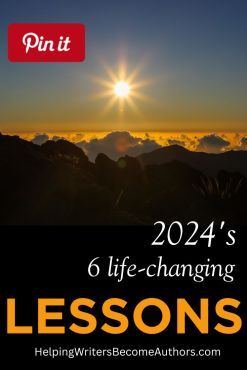 No lie—it feels strange to be sitting here writing you this post. Every year, I open the new year with a reflection on everything I learned in the previous year and a look forward into my intentions for the year to come. When I first started this tradition, I focused mostly on the specific lessons I was learning in my own writing, but as time has gone on, the writing lessons have had such an impact on my life and the life lessons have had such an impact on my writing, that these retrospective posts have expanded into something much broader and more personal.
No lie—it feels strange to be sitting here writing you this post. Every year, I open the new year with a reflection on everything I learned in the previous year and a look forward into my intentions for the year to come. When I first started this tradition, I focused mostly on the specific lessons I was learning in my own writing, but as time has gone on, the writing lessons have had such an impact on my life and the life lessons have had such an impact on my writing, that these retrospective posts have expanded into something much broader and more personal.
One year ago, I sat here and wrote to you about how I felt the previous year had been the culmination of an important Flat Arc period for me. I talked about what this period had taught me about the importance and complexity of Flat Arcs—character arcs in which the protagonist does not change but builds upon previously integrated Truths, as the foundation for eventually evolving the status quo yet again in future Change Arcs. I hinted I was coming to the end of this particular Flat Arc in my own life and standing on the brink of something new and momentous.
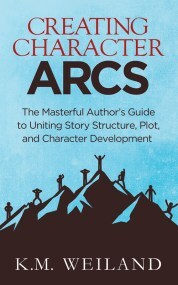
Creating Character Arcs (Amazon affiliate link)
On this blog, I don’t share too much about the personal details of my life, since the main focus is, of course, helping writers become authors and authors become artists. But art draws from life, just as life builds upon art. If you’ve been following along in these New Year posts over the last half dozen years or so, you know I’ve been on quite a transformative journey, one that has challenged and evolved me in just about every area—not least in my relationship and perspective on art and story. In many ways, the First Plot Point of that journey was when I took the leap on a huge and, in many ways, traumatic move in 2018. I moved to a little farmhouse in Missouri, where I stayed and learned and grew and experienced pain and joy on levels I had never even known were possible. That was my last Change Arc.
Then circumstances dictated I move back. My intentions were to pitstop with my parents for a few months, then move to the West Coast. I ended up staying two plus years, caught partly between the throes of my own indecision and the housing market and, partly, in my deepest wisdom, the knowledge that I needed to take a minute to let myself fully live into my Flat Arc, as I processed and integrated the changes that had so radically altered my life not so very much earlier.
During that time, I made significant progress in healing my burnout and my relationship to writing fiction after four years of terrifying writer’s block. The last two years were a period of tremendous peace and blessing, but also years wracked with frustration, doubt, and uncertainty. At the end of last year, I decided to spend my birthday month in the mountains on the border of New York and Massachusetts. I have always believed that when we feel stuck, sometimes it is better to do anything—even if it is a mistake—rather than to do nothing at all. Just the act of moving the energy can change things up enough to evolve perspectives and reveal new possibilities (incidentally, this is also good advice when plotting a story).
That trip (I called it my Scorpio portal) changed everything for me. I came home and did what I do best: made a plan. I finally got super clear on the sweet spot where exactly what I wanted met up with exactly what options were open to me. I made the commitment that either I was buying a house in state by August, or I was giving up on the local market ever giving me what I wanted and moving out of state to rent once again. For the first time, instead of waiting around for something to happen (aka, the perfect situation to be offered to me), I started moving forward with intention, doing everything I would need to do if I was going to move.
 I knew my ideal moving month was April, so I worked up a tight but (mostly) manageable schedule to do all the work I possibly could in the first four months of the year. By Christmastime, something happened that hadn’t happened in the previous two years: a house I really liked came up on the market. I looked at it, loved it, put a contract on it—and then the whole thing fell through after house inspections revealed major problems. A month later, the realtor let me know the owners might be willing to get everything fixed, so I went back to look again—only to have someone else put a contract on it first.
I knew my ideal moving month was April, so I worked up a tight but (mostly) manageable schedule to do all the work I possibly could in the first four months of the year. By Christmastime, something happened that hadn’t happened in the previous two years: a house I really liked came up on the market. I looked at it, loved it, put a contract on it—and then the whole thing fell through after house inspections revealed major problems. A month later, the realtor let me know the owners might be willing to get everything fixed, so I went back to look again—only to have someone else put a contract on it first.

Structuring Your Novel: Revised and Expanded 2nd Edition (Amazon affiliate link)
So I went back to work. I wrote 90% of the year’s blog posts, recorded and edited podcasts, filmed videos, created the Shadow Archetypes email course, edited the second edition of Structuring Your Novel, and prepared for publication its “sequel” Next Level Plot Structure.
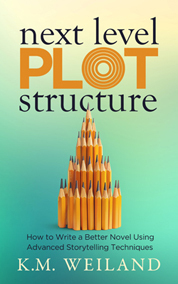
Next Level Plot Structure (Amazon affiliate link)
Then, in March, my brother-in-law texted me a link to a house that had just come onto the market. As soon as I opened the link, I knew exactly what I was looking at. It was my “dream house.” It was a house that had first come onto the market three years earlier, when I was still in Missouri and just starting to look. It was everything I wanted, but at the time I wasn’t in a position to pursue it (not least because I wasn’t sure where I wanted to move). Throughout the long process of struggling to find anything in the area that I liked, this was the house I kept coming back to. Every time I got discouraged because another house I didn’t like came onto the market, I would go back to the old listing for this one and remind myself that if it was there, then something else I liked would be as well.
And then that house itself came onto the market! I was the first one to see it and the first one to offer on it. A friend who already lived in the neighborhood told me later that when they had first moved in many years ago, they had driven by this house and randomly commented, “And that is Katie Weiland’s house.”
I felt so held and led by the synchronicities, so blessed to be given not just a house, but the house.
My Flat Arc was officially over. The status quo was forever changed. Cue the next Change Arc. Once more unto the brink, my friends!
The 6 (Biggest) Lessons That Changed My Life in 2024Obviously, this was a huge year for me. As a first-time house owner, I was learning or experiencing something new around every corner. As someone who relies on schedules and routines, and who struggles to acclimate to new spaces, it was a year that stretched me nearly every single day. Truly, it has been a portal. I am still not quite sure who I am on the other side, but I know I am not the same. Who I am will unfold, helped no doubt by everything I will write to you in the coming year.
So much of the year passed in a blur. I look forward to re-reading my journals from this year, because honestly I have no idea what I wrote in them! Every day, I was feeling and thinking something new. For me, this move was not simply a new place to live; it was adamantly the closing of one chapter and the opening of the next. It was an epoch (because, let’s be honest, I don’t know how to do it any other way). Necessarily, it is difficult to take such a life-changing experience and distill it into a short list of pertinent lessons. But as I scan back over the twelve months since I last sat down to write to you like this, these are the six lessons that particularly jump out at me.
1. Take the LeapFor many years, I have kept on my nightstand a small framed quote. It says:
Everything you want is on the other side of fear.
For many reasons, making this huge life change scared me. In the intervening years as I tried to figure out what I wanted to do, I knew part of what was holding me back was fear—fear of the unknown, fear of the responsibility and risk, fear of revisiting old trauma. I read somewhere that the three most stressful life events are major illness, death of a loved one, and moving. As excited and aligned as I felt about the decision, I was terrified. About a week after closing, I spent a solid twenty-four hours shaking and crying. Once I actually moved in, it felt like I’d jumped into an abyss.
For years, I have worked with the discipline of feeling into pain and fear as a way of moving through them. But now, I was truly in them—truly feeling them in my body… and moving them through. The limited perspective of my logical self believed the shaking and crying meant something was wrong. But my body knew better. My body was doing what it did best—like a dog shaking itself off—moving all this stuff through my system.
For years, I have been faithfully showing up to the personal practices that have asked me to confront my own limitations, constrictions, and shadow. Now, that work was paying off. The resources were there for me draw on, and I was able to keep moving forward—to “do what is front of me”—because underneath all the chaos, there was, for perhaps the first time in my adult life, the certainty that everything was okay, that this was all just part of the process, and that I only needed to be faithful to it and to remain present to myself.
And then something happened. There were moments where I felt… amazing. I felt better than I have felt ever. I felt such gratitude. Such joy. Such pleasure. It just bubbled up out of me. And then the hard parts would come again. But I began to gain the perspective that this feeling of joy was always there. Finally, I had cleared enough of my own junk to be able to see it, and in seeing it, I knew that this was a truer and deeper part of myself than anxiety or grief could ever be.
A few months in, it dawned on me: So this was what was on the other side of fear all along?! If I had known that, I would have blasted through it a long time ago! I realized I had been believing a Lie—the belief that on the other side of fear was just more fear, endless terror, and pain. But the Truth? The Truth was that the fear just needed to be moved out—in a painful process that certainly required bravery and resourced discipline—but after it was out, it was out.
I never would have learned that if I hadn’t been willing to take the leap in the first place.
2. Plan AheadAnother quote I have kept somewhere handy for a long time is:
Do something your future self will thank you for.
Most of the time, I think of this quote in respect to the big things (like buying a house), but this year, it became clearer than ever to me that sometimes the future self I’m serving isn’t too far removed from my present self.
Without question, the greatest thing I did to help myself through this transition was putting in the work before I ever put a contract on the house. I worked like a crazy person during the first quarter of the year, doing a year’s worth of work—including the blog/podcast and three major projects—in four months’ time. The first couple of months went really well and felt manageable. The second two—after I put the contract on the house—admittedly pushed the redline pretty hard. This was something I had done my utmost to avoid in previous years, since I had pushed myself to burnout previously and definitely didn’t want a repeat performance.
But it was a sacrifice I made that my future self was endlessly grateful for throughout the year, since it allowed me to focus all my energy on not just the practical stresses of physically moving and making a home, but on my emotional needs in processing the tremendous changes I was creating in my life. Today’s post is the first post I’ve written since February 2024. The break—although hardly a sabbatical—was welcome in its own right and has brought so much space into my ability to think about what I want to share and how I want to serve this community going forward.
As for fiction, after closing, I decided to set it aside until I was settled in. My writer’s block was triggered the last time I moved, something I definitely didn’t want to repeat. This time, I also tried to honor my future creative self by giving her permission to focus her creative energies on building the foundation of a creative life to come.
3. Accepting Help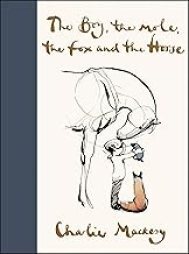
The Boy, the Mole, the Fox, and the Horse by Charles Makesy (affiliate link)
This summer, I ran across a beautiful quote from the book The Boy, the Mole, the Fox and the Horse by Charles Makesy:
Asking for help isn’t giving up. It’s the opposite.
I was blessed to be deeply supported by others throughout this transition, particularly by my parents and by my brother who was able to come down and spend six months with me, helping me move. The last time I moved, I felt very alone, for many reasons (some of which weren’t, in fact, true). This time, I was humbled and healed by not just the help that was always on offer, but by my own ability to reach out and ask, in ways I had never let myself do before.
The last several years have been the saga of my heart’s opening—something that in many ways was initiated by the birth of one of my nephews and has been, ultimately, the journey of learning to love and accept myself ever more deeply. It has been a quest to understand what it means to love and be loved, to explore the endless complexity of the query, “What is Love?”
Something I learned this year that seems utterly simple to recount, but which was profoundly life-changing is the realization that a true experience of Love is as much, if not more, about receiving as it is about giving. When it was growing near time for my brother to return home, I was remembering and recounting all the ways he had blessed me this summer, feeling into the true depth of his love for and service to me—and as I spoke my gratitude to him, I could see in his eyes how loved he felt by my recognition of his love for me. I realized that the love I was often trying to “push” out of myself toward others was a pale reflection of the love that emanated when I simply sat and received and recognized the essential lovingness of those in my life.
Counter-intuitive as it may seem, perhaps it is not untrue to say that when we cannot receive, we cannot truly love.
4. Surrendering“Be Ground
Be crumbled, so wildflowers will come up where you are.
You’ve been stony for too many years.
Try something different.
Surrender.”
–Rumi
Here’s maybe the biggest and most ironic thing I learned this year. For a long, long time now, I thought buying a house would give me a sense of security and stability in this life. Almost right away, however, it became clear to me that the exact opposite felt much truer. This year has challenged me with one of the most profound practices of surrender in my entire life.
I thought having a piece of ground to call my own would make feel rooted and proof against the changing times, but so far, nothing could be farther from the truth. Anxieties I either thought I had long laid to rest or didn’t even know I had came roaring out of the shadows. Everything felt so much more uncertain. The future suddenly seemed full of tripwires and a host of potential tragedies and misfortunes.
Instead of feeling like I now had something substantial to call my own, it felt like now I had something to lose. And my instinct was clamp down as hard as I could in a futile attempt to comfort myself with the conviction that I could control what happened to my future.
When I was young, I often felt my life was a straight road to the horizon. The older I get, the more I discover it isn’t a road at all, but a wide-open wilderness. Ultimately, I count that a good thing. But it’s scary as hell. And so, this year has been—and continues to be—a practice in surrender, a practice in opening my hand and letting life flow through my fingers. If there is one thing I keep coming back to in my deepest heart, it is the commitment to living to my highest path and purpose in this life—whatever it takes. In the abstract, I already know that “what it takes” is listening for the truth that “whatever each moment brings is my highest path and purpose.” That is the lodestone I always return to. House, no house, failure, success —whatever—it’s not the point. The point is listening for and living into my deepest understanding of Truth in each moment.
5. GratitudeWhen the bursts of anxiety grabbed me especially hard this year, I would look around at this amazing opportunity I had been given, and I would tell myself, “Girl, what are you doing? You couldn’t possibly be more blessed.” I would tap into my longtime practice of feeling wherever gratitude was in my body—and wherever it was there, too, was space and peace.
In re-reading an old journal entry, I ran on to a quote I had saved:
Thank you for everything; I have no complaints whatsoever.
That simple little meditation has become the mantra of my year. “Thank you for everything. I have no complaints whatsoever.” I look around me right now, and it is true. I have no complaints. And as I sit in that feeling and think of all the things my anxiety wants me to be afraid of, I realize this will be just as true even if every single one of those things (improbably) did happen.
Thank you for everything. I have no complaints whatsoever.
My gratitude for this journey overflows. I am filled with so, so much gratitude for the fulfillment of a dream I have dreamed for so many years. I overflow with gratitude for the journey that has brought me here, for the person I have fought to become, the person who was brave enough and committed enough to keep going, to keep believing, to not give up. I am grateful for the experience I get to have right now—for this new home and all the experiences and lessons it has already brought to me.
That gratitude will remain no matter what comes next. Whether I am here for a year or ten years, I will always have gotten to live this and to have been the person who made it happen. If my life so far has taught me nothing else, it has taught me that however hard things may sometimes be, everything always happens the way it is supposed to. All I have to do is listen and trust and do and open my heart into the gratitude for the all that is life itself.
6. Reflection and New DirectionsBetween stimulus and response there is a space. In that space is our power to choose our response. In our response lies our growth and our freedom.–Victor Frankl
These retrospective New Year posts are always quite long, and I know they’re not to everyone’s tastes (don’t worry, we’ll get back to the writing next week!). But I want to close with this powerful quote from a powerful man.

Writing Archetypal Character Arcs (affiliate link)
Good storytellers are always aware of the power of the pause. That moment of pregnant possibilities between action and reaction is where all of story—and life—is born. I would argue that this quote ultimately points, once again, to the power and importance of Flat Arcs. After the great flurry of a Change Arc comes the moment where you get to stop and look back at the road behind you and see how far you have come. In a truly transformative arc, you will no longer be able to even see where it was you started from.
And then you look forward once more—to the road ahead. Perhaps it seems to be straight for a while—Flat—as you catch your breath. You are in Frankl’s “space.” This is the foundation for all that is yet to come. How will we integrate all we have learned? What will we build next?
For me, honestly, I have no idea. I’m still catching my breath. In fact, perhaps I have not yet reached the Flat part of the road. My Change Arc may not be over. Certainly, I feel the dust is still settling, and I’m still looking alongside the road for a nice clear pond in which I can view my reflection and see just who it is I have now become. I do know that the year ahead will be one of yet more integration and many more lessons. It will be full of more stories and more musings on story, and I look forward to sharing it all with you!
Whether you currently find yourself on a Change Arc or the Flat part of the road, I am wishing you a momentous 2025 and thanking you, always, for being my fellow travelers.
Wordplayers, tell me your opinions! What were your biggest growth moments in 2024? What are your intentions for the New Year? Tell me in the comments!Click the “Play” button to Listen to Audio Version (or subscribe to the Helping Writers Become Authors podcast in Apple Podcast, Amazon Music, or Spotify).
___
Love Helping Writers Become Authors? You can now become a patron. (Huge thanks to those of you who are already part of my Patreon family!)The post Reflecting on 6 Life-Changing Lessons in 2024 appeared first on Helping Writers Become Authors.
December 30, 2024
2024 in Review: My Top 10 Writing Post (and Other Things)
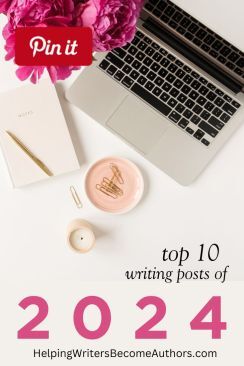 What a year this has been! For me, it was a year utterly defined by the major life change of buying and moving into a new house. (I’ll talk more about that in my annual New Year retrospective, for those interested in my personal adventures.) On the writing front, this meant I tackled the (possibly crazy) feat of cramming a year’s worth of work (including a course, two books, and 40+ blog posts and podcasts) into four months, freeing me up for the incredible adventure of making a new home.
What a year this has been! For me, it was a year utterly defined by the major life change of buying and moving into a new house. (I’ll talk more about that in my annual New Year retrospective, for those interested in my personal adventures.) On the writing front, this meant I tackled the (possibly crazy) feat of cramming a year’s worth of work (including a course, two books, and 40+ blog posts and podcasts) into four months, freeing me up for the incredible adventure of making a new home.

Structuring Your Novel: Revised and Expanded 2nd Edition (Amazon affiliate link)
In prepping the second edition of Structuring Your Novel, I realized I had collected so many new ideas and information that I really had a second book’s worth! I didn’t want to change Structuring Your Novel *too* much, so I released a brand new book, Next Level Plot Structure. This book goes much deeper into story theory to explore the idea of chiastic, or ring, structure, in which the beats in each half of the story mirror each other, as well as how every plot beat consists of two crucial halves.
Next Level Plot Structure (Amazon affiliate link)
I was also able to release the long-awaited audiobook version of Writing Archetypal Character Arcs. (And, yes, for those wondering, the audio version of the second edition of Structuring Your Novel should be out very soon—just after the first of the year—and Next Level Plot Structure will follow.)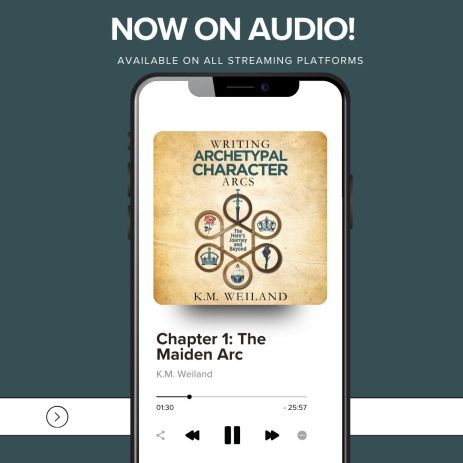
Writing Archetypal Character Arcs audiobook (affiliate link)
Helping Writers Become Authors was also granted its 11th mention on Writer’s Digest‘s list of 101 Best Websites for Writers, which is always a tremendous honor.
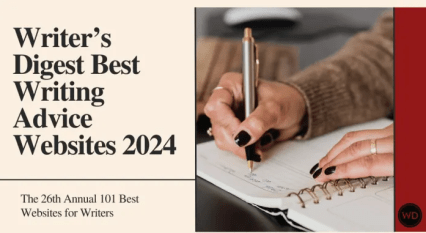
Moving into 2025, I am excited to see what the new year brings. Aside from my own personal growth stretches, 2024 was also a year of changes on the business front. Google’s AI updates are changing the Internet landscape, and I will definitely need to sit down and see what I can do to adjust and make sure HWBA stays up to date and as relevant as possible. Thank you all for your recent suggestions about how I can best serve you in the coming year. I will be reviewing all your ideas and posting about as many of them as possible.
For those wondering, I am planning to release a similarly updated second edition of the Structuring Your Novel Workbook, which will mirror the changes made in the main book this year.
I also have a brand new idea up my sleeve. Building on the success of the Archetypal Character Guided Meditations I released last year, I’m wanting to see if I can figure out a way to bring these dreamzoning tools to some live sessions where we can all dream our stories together. Stay tuned for more on that!
And, of course, I hope to pick up my fiction WIP once more. I continue my adventure with learning how to honor and nurture the creative spirit, something I’m sure I will be sharing with all of you.
See you around the corner!
My Top 10 Posts of 2024And now, just in case you missed them (or want to revisit them):
1. From Lead to Gold: The Alchemy of Character Arc With Carl Jung
2. 6 Tips to Write Deeply Emotional Fiction
3. Writing Multiple Plotlines: Everything You Need to Know
4. How to Use Symbolic and Archetypal Settings in Your Story
5. Checklist for Beginning Your Story: Introducing Your Characters
6. Checklist for Beginning Your Story: Plot Considerations
7. 5 Reasons Story Structure Is Important
8. A Writer’s Comprehensive Guide to Backstory
9. 12 Places to Find a Beta Reader
10. How to Use Antagonists in Your Story: The Right Way and the Wrong Way
Wordplayers, tell me your opinions! What was the most memorable writing event for you in 2024? Tell me in the comments!The post 2024 in Review: My Top 10 Writing Post (and Other Things) appeared first on Helping Writers Become Authors.
December 23, 2024
Merry Christmas, Wordplayers!
Merry Christmas, Wordplayers!
I always feel a poignancy at Christmastime. Here in the darkness of the year, every moment of light seems all the more potent—pregnant with meaning, if only I can become still enough to see it, to hear it, to understand it in deepest depths of myself.
I look back on all that has been, and for me, it has been a whirlwind year—a blur of light and colors. When I sat down a year ago to write this same note to you, I knew I was standing on the brink of a portal, about to walk through and change myself and my life forever. That portal involved finally resolving a years’ long decision-making process to buy a house.
It was not a year of much writing. It was a year in which almost everything I shared with you (two books, a course, and a years’ worth of posts, podcasts, and videos) was written in blur all within fourth months’ time—and then almost eight months of focusing on everything else life had to give me (and to throw at me).
Now, as I look forward to the horizon and the brave new year that promises to crest into view at any moment, I know this is uncharted territory. And I know I am not alone. So much has changed for all of us in such a short amount of time. None of us is who we were a year ago, never mind five years or ten years ago.
I don’t know who I will be going forward. I don’t know who you will be. But, as ever, I am here for this journey that is ours to walk together. I imagine us standing at the beginning of a road. We look at each other and we nod and we know. We know what this road means—because we are storytellers.
We light the way, first for ourselves and then for all those who walk behind us. It is a wide-open road. It is a book of blank pages. What we write is up to us. As we celebrate in the pockets of love and light that spangle the winter darkness, may we rise into this new year to write our deepest, most transformative, most daring, most life-changing, world-changing, self-changing stories yet.
See you on the other side.
Merry Christmas!


The post Merry Christmas, Wordplayers! appeared first on Helping Writers Become Authors.




